UNIFIED DEVELOPMENT ORDINANCE
ADMINISTRATION AND PROCEDURES
Section 11-6-1. Purpose and Organization of this Article. This article describes the review and approval procedures for applications for land use and development in the City of Northglenn.
(1)
Section 11-6-3, Common Development Review Procedures, describes the standard procedures that apply to most development applications.
(2)
Sections 11-6-4 through 11-6-7 contain specific information on each application type, including approval criteria and any additions or modifications to the common review procedures.
(3)
Section 11-6-8, Review and Decision-Making Bodies, contains descriptions of the review and decision-making authorities, including the City Council, Planning Commission, Board of Adjustment, Director of Planning and Development, Development Review Committee, and other City officials.
[Source: Ord. 1766, 2019]
Section 11-6-2. Summary Table of Development Review Procedures. Table 6.A on the following page lists the development applications authorized in this UDO. For each type of application, the table indicates whether a pre-application conference is required and the role of City review and decision-making authorities.
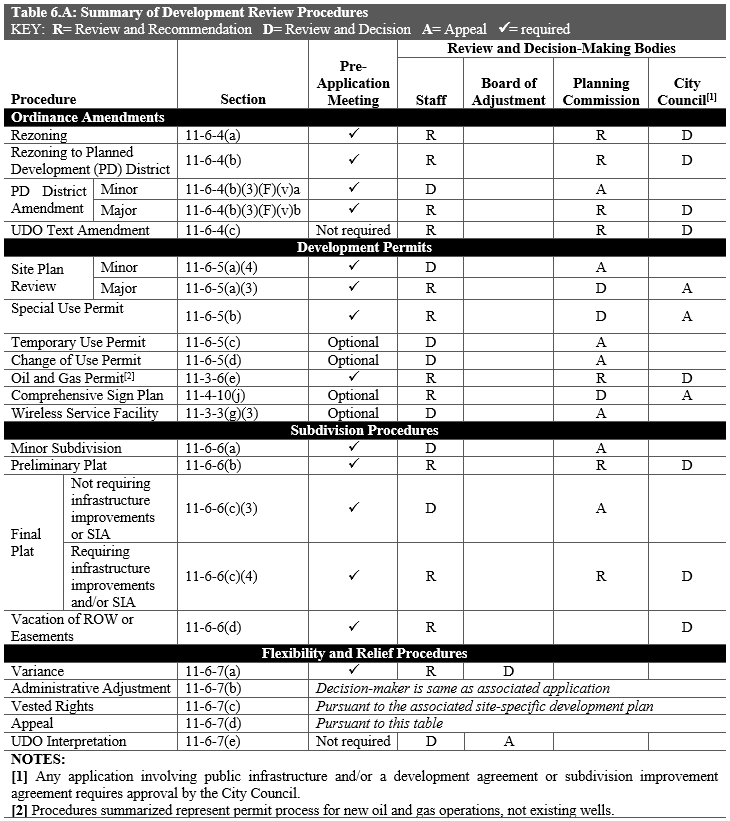

[Source: Ord. 1766, 2019; 1782, 2019; 1870, 2025]
Section 11-6-3. Common Development Review Procedures.
(a)
General. This section describes the standard procedures and rules applicable to all development applications unless otherwise stated in this UDO. Common Review Procedures include six steps, not all of which are applicable to every development application. Application-specific procedures in Sections 11-6-4 through 11-6-7 identify additional procedures and rules beyond those in this section.
(b)
Pre-Application Meeting.
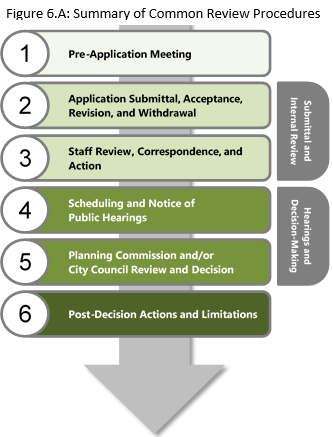
(1)
Purpose. The pre-application meeting is intended to provide an opportunity for the applicant to meet with City staff to review submittal requirements, procedures, and schedules; discuss details and potential impacts of the proposed project; and establish points of contact for the development review process.
(2)
When Required. Pre-application meetings are required between City staff and the applicant according to Table 6.A, Summary of Development Review Procedures.
(3)
Procedure. Pre-application meetings shall be scheduled in accordance with the following procedures.
(A)
Request. The applicant shall submit a request for a pre-application meeting to the Planning and Development Department.
(B)
Scheduling. The Director shall schedule pre-application meetings and notify appropriate staff and the applicant of the time and location of the meeting.
(C)
Required Information. The applicant shall submit:
(i)
A written description of the proposed project;
(ii)
Conceptual drawings showing the location, layout, and primary elements of the proposal;
(iii)
Specific uses, location of uses, and densities proposed;
(iv)
Proposed construction phasing (if applicable); and
(v)
Proposed location of required public improvements (if applicable).
(D)
Conference Determinations. City staff attending the pre-application meeting shall identify concerns or factors the applicant should consider related to the scope, features, and potential impacts of the project as they relate to this UDO. City staff shall also indicate to the extent possible whether additional approval procedures are required for the proposed project.
(4)
Effect. Any information or discussions held as part of the pre-application conference shall not be binding on the City or the applicant. Discussions of potential conditions to mitigate impacts do not reflect actions by the decision-making body until and unless a decision-making body takes formal action to attach that condition to a development approval.
(c)
Application Submittal, Acceptance, Revision, and Withdrawal.
(1)
Authority to Submit Application. Unless expressly stated otherwise in this UDO, a development application shall be submitted by:
(A)
The owner, contract purchaser, or any other person having a recognized property interest in the land on which development is proposed;
(B)
A person authorized to submit the application on behalf of the owner, contract purchaser, or other person having a recognized property interest in the land, as evidenced by a letter or document signed by the owner, contract purchaser, or other person; or
(C)
If there are multiple owners, contract purchasers, or other persons authorized to submit the application, all such persons shall sign the application or a letter or document consenting to the application.
(2)
Application Content.
(A)
The application shall be submitted to the Planning and Development Department.
(B)
The application shall be submitted on a form established by the Director.
(C)
The applicant bears the burden of ensuring that an application contains sufficient information to demonstrate compliance with application requirements.
(3)
Application Fees.
(A)
Application fees shall be paid at time of submittal according to the type of application. Fees shall be established by resolution by the City Council.
(B)
All fees required by this UDO shall be paid to and collected by the Planning and Development Department, subject to Article 1 of Chapter 18 of the Municipal Code.
(C)
Where initial application fees are based on the estimated costs of review of the application by an outside consultant (for example, review of a project's traffic impacts by a traffic consultant), and the Director determines that additional funds are needed to complete the consultant's review, the Director may impose additional application fees to recover the City's actual costs in completing review. Prior to imposing such additional fees, the Director shall notify the applicant of the additional fees and provide the applicant with the option to move forward or withdraw the application.
(D)
If the City incurs costs beyond the amount deposited with the City and the applicant does not pay those costs within 30 days after written notice from the City, the City shall be entitled to a lien for those costs on the land being developed. The approval document for any application type with outstanding application fees shall not be recorded until such fees are paid in full.
(4)
Submittal and Review Schedule. The Director shall establish a submittal and review schedule for development applications and shall include that information in the Administrative Manual. The Director may amend the schedule to ensure effective and efficient review under this UDO.
(5)
Determination of Application Completeness. The Director shall determine whether the application is complete or incomplete within five business days. The Director shall provide written notification of application acceptance or denial.
(A)
Complete Applications. A complete application shall be processed for review according to the procedures in this article. An application will be considered complete if it is submitted in the required form, includes all required information specified in this UDO and the Administrative Manual, and is accompanied by the applicable fee.
(B)
Incomplete Applications. An incomplete application shall not be processed or reviewed. The Director shall provide written notice of the submittal deficiencies. The applicant may correct the deficiencies and resubmit the application for determination of application completeness. An incomplete application that is not resubmitted within 60 days shall be considered abandoned.
(6)
Minor Application Revisions. An applicant may revise an application after receiving notice of compliance deficiencies following staff review according to Subsection (d), or on requesting and receiving permission from an advisory or decision-making body after that body has reviewed, but not yet taken action on, the application. Revisions shall be limited to changes that directly respond to specific requests or suggestions made by staff or the advisory or decision-making body, as long as they constitute only minor additions, deletions, or corrections and do not include significant substantive changes to the development proposed in the application, as determined by the Director. All other application revisions shall be processed as a new application per this Subsection (c).
(7)
Application Withdrawal.
(A)
After an application has been accepted for review, the applicant may withdraw the application at any time by submitting a letter of withdrawal to the Director.
(B)
If an application is withdrawn after required notice of any scheduled public hearing, the application shall be subject to limitations on the subsequent submittal of similar applications (See Subsection (h)(5), Post-Decision Actions and Limitations).
(C)
An applicant is not entitled to a refund of application fees for withdrawn applications. However, the Director may refund fees not expended during the first round of staff review if the application is withdrawn within 10 days of acceptance and prior to preparation or distribution of any official written comments.
(d)
Staff Review, Correspondence, and Action.
(1)
Refer Application to Development Review Committee, Staff, and Review Agencies
The Director shall distribute the complete application to appropriate staff and appropriate internal and external review agencies per the Administrative Manual.
(2)
Staff Review and Application Revisions. Staff shall review the application and submit recommendations and comments to the applicant in a form established by the Director. The application will not move forward for further review until the applicant adequately responds to staff recommendations and comments.
(3)
Applications Subject to Staff Recommendation.
(A)
Staff Report. If an application is subject to staff review and recommendation to the Planning Commission or City Council per Table 6.A, the Director shall prepare a written staff report. The staff report shall state whether or not the application complies with all UDO requirements and shall include a recommendation for a decision by the authorized decision-making body. The staff report may also recommend how noted deficiencies may be corrected and negative impacts mitigated.
(B)
Distribution and Availability of Application and Staff Report. Within a reasonable time period before a meeting or hearing at which a development application is scheduled for review by an advisory or decision-making body, the Director shall submit a copy of the staff report to the applicant and advisory or decision-making body, and shall make the staff report and all related materials available for public review.
(4)
Applications Subject to Staff Decision.
(A)
Decision. If an application is subject to staff review and a final decision by the Director per Table 6.A, the Director shall make a decision based on the review standards applicable to the application type. The decision shall be in writing and shall clearly state reasons for a denial or for conditions of approval.
(B)
Conditions of Approval. Any conditions of approval shall be limited to conditions deemed necessary to ensure compliance with the requirements of this UDO, and shall relate to the anticipated impacts of the proposed development.
(e)
Scheduling and Notice of Public Hearings.
(1)
Scheduling.
(A)
If an application is subject to a public hearing per Table 6.B, the Director shall schedule the public hearing for either a regularly scheduled meeting or a special meeting of the appropriate decision-making body.
(B)
The public hearing shall be scheduled to allow sufficient time to prepare a staff report per Section (d)(3).
(2)
Public Hearing Notice.
(A)
General Notice Requirements. All public hearings required by this UDO shall be preceded by the notices identified in Table 6.B.
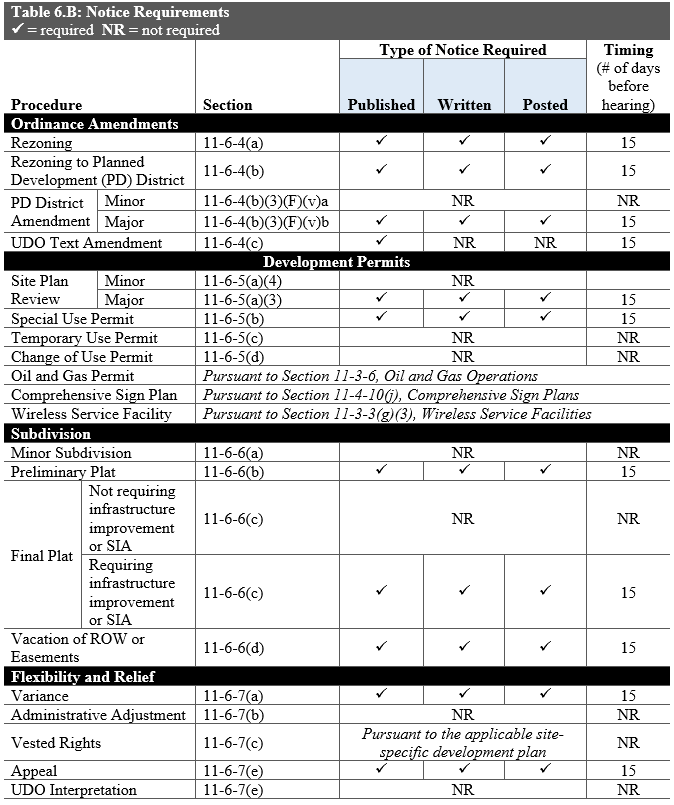
(B)
Notice Format and Content.
(i)
Published and Mailed Notice.
(a)
A notice for any application requiring published or mailed notice per Table 6.B shall:
(1)
Identify the application type;
(2)
Describe the nature and scope of the proposed project;
(3)
Identify the location of land subject to the application;
(4)
Identify the date, time, and location of the hearing being noticed;
(5)
Identify where and when the application and materials may be inspected; and
(6)
Indicate opportunity to appear at the public hearing.
(b)
Published notice shall appear in a newspaper of general circulation in the City at least 15 days prior to the scheduled public hearing.
(c)
Mailed notices shall be sent via first class mail to all property owners within 300 feet of the subject property within the City of Northglenn, as measured from property boundaries.
(ii)
Posted Notice.
(a)
For an application requiring posted notice per Table 6.B, at least one sign shall be posted on the parcel at least 15 days prior to the scheduled hearing. The sign shall be clearly visible from the most heavily traveled adjacent street or public right-of-way and shall remain on the property until after the hearing.
(b)
The Director may require additional signs based on access and configuration of the property.
(c)
Required posted notice shall:
(1)
Identify the application type;
(2)
Describe the nature and scope of the proposed project;
(3)
Identify the date, time, and location of the hearing being noticed; and
(4)
Identify a telephone number for additional information.
(C)
Request to Continue Scheduled Hearings. An applicant may request that review of an application scheduled for a public hearing be continued in accordance with the following provisions.
(i)
Before any notice is published, mailed, or posted, a written request that states the reasons for continuance shall be submitted to the Director, who may grant the request for good cause shown.
(ii)
Any subsequent request for continuance shall be in writing, state the reasons for continuance, and be submitted directly to the body scheduled to review the application. The appropriate body shall consider such a request and may either grant or deny the request and proceed to hear public comments, review, and take action on the application. If the body grants the request for continuance, it shall concurrently identify the date and time of a subsequent meeting at which the application shall be scheduled for public comments and review. The applicant may be subject to additional application fees to defray additional costs of processing the application.
(D)
Constructive Notice.
(i)
Minor defects in any notice shall not impair the notice or invalidate proceedings pursuant to the notice if a bona fide attempt has been made to comply with applicable notice requirements. Minor defects in notice shall be limited to errors in a legal description or typographical or grammatical errors that do not impede communication of the notice to affected parties. In all cases, however, the requirements for the timing of the notice and for specifying the time, date, and place of a hearing shall be correctly conveyed.
(ii)
Failure of a party to receive written notice shall not invalidate subsequent action. If questions arise at the public hearing regarding the adequacy of notice, the decision-making body shall make a formal finding as to whether there was substantial compliance with the notice requirements of this UDO.
(f)
Planning Commission and/or City Council Review and Decision.
(1)
Hearing, Review, and Decision.
(A)
The application shall be subject to review, hearings, recommendations, and decisions as indicated in Table 6.A, Summary of Development Procedures.
(B)
If the application is subject to a public hearing, the applicable review body shall hold a public hearing on the application in accordance with Subsection 11-6-3(g), Public Hearing Procedures.
(C)
The applicable review body shall consider the application, relevant support materials, staff report, and any evidence and public comments from the public hearing (if required).
(D)
The applicable review body shall approve, approve with conditions, or deny the application based on the applicable approval criteria.
(E)
If the review involves a quasi-judicial hearing, the recommendation or decision (as applicable) shall be based only on the record of the public hearing and shall be made in writing; include findings of fact based on competent, material, and substantial evidence presented at the hearing; reflect the determination of contested facts; and state how the findings support compliance with applicable review standards.
(F)
The applicable review body shall clearly state the factors considered in making its recommendation or decision, as well as the basis or rationale for the recommendation or decision.
(2)
Conditions of Approval.
(A)
Where this UDO authorizes a review body to approve or deny an application subject to applicable criteria, the review body may approve the application with conditions necessary to bring the proposed development into compliance with this UDO or other regulations, or to mitigate the impacts of that development on the surrounding properties and streets.
(B)
All conditions of approval shall be reasonably related to the anticipated impacts of the proposed use or development or shall be based upon standards duly adopted by the City. Such conditions may include those necessary to carry out the purpose and intent of the Comprehensive Plan, other adopted City plans, and this UDO. No conditions of approval shall be less restrictive than the requirements of this UDO, except where the UDO expressly allows deviations.
(C)
Any condition of approval that requires an applicant to dedicate land or pay money to a public entity in an amount that is not calculated according to a formula applicable to a broad class of applicants shall be roughly proportional both in nature and extent to the anticipated impacts of the proposed development, as shown through an individualized determination of impacts.
(D)
During its consideration, the decision-making body may consider alternative potential conditions, and no discussion of potential conditions shall be deemed an attempt or intent to impose any condition that would violate the federal or state constitutions, statutes, or regulations. Discussions of potential conditions to mitigate impacts do not reflect actions by the decision-making body unless and until the decision-making body takes formal action to attach that condition to a development approval.
(E)
Unless otherwise provided in this UDO, any representations of the applicant in submittal materials or during public hearings shall be binding as conditions of approval.
(g)
Public Hearing Procedures. Public hearings required by this UDO shall be conducted pursuant to Section 11-6-8, Review and Decision-Making Bodies, the bylaws established by the respective bodies, and in compliance with state law.
(h)
Post-Decision Actions and Limitations.
(1)
Notice of Decision.
(A)
Within 10 days after a final decision on an application, the Director shall provide written notification of the decision via personal delivery, electronic mail, or first-class mail to the applicant and make a copy of the decision available to the public in the Planning and Development Department.
(B)
If the review involves a quasi-judicial hearing, the Director shall, within 10 days after a final decision on the application, also provide a written notification of the decision via personal delivery, electronic mail, or first-class mail to the owner(s) of the subject site, and any other person that submitted a written request for a copy of the decision before its effective date.
(2)
Appeal.
(A)
A party aggrieved or adversely affected by any decision by the City Council or Board of Adjustment may seek review of the decision in the courts in accordance with applicable state law.
(B)
A party aggrieved by other final decisions may appeal the decision in accordance with the procedures and standards in Subsection 11-6-7(d), Appeal.
(3)
Expiration of Approval.
(A)
An application approval shall be valid as authorization for the approved activity unless it expires in accordance with expiration time periods provided in Sections 11-6-4 through 11-6-7 for the particular type of application.
(B)
A change in ownership of the land shall not affect the established expiration time period of an approval.
(C)
The Director may grant extensions of the expiration time period for up to one year, following a written request for such extension prior to the expiration date. The request shall include reasonable cause for an extension. Further extensions shall be subject to the approval of the decision-making body for the original application.
(4)
Modification or Amendment of Approval. Unless otherwise provided in this UDO, any modification of an approved plan, permit, or condition of approval shall require a new application that is submitted and reviewed in accordance with the full procedure and fee requirements applicable to the particular type of the original application.
(5)
Limitation on Subsequent Similar Applications. Following denial of an application, the decision-making body shall not decide on applications that are the same or substantially similar within one year of the previous denial. This waiting period may be waived by the decision-making body provided that:
(A)
There is a substantial change to circumstances, or new information available, relevant to the issues or facts considered during the previous application review; or
(B)
The new application is materially different from the previous application, as determined by the Director.
[Source: Ord. 1766, 2019]
Section 11-6-4. Ordinance Amendments.
(a)
Rezoning.
(1)
Purpose.
(A)
The purpose of the rezoning procedure is to make amendments to the Official Zoning Map of the City of Northglenn to reflect changes in public policy, changed conditions, or to advance the welfare of the City. The zoning classification of any parcel in the City may be amended using this procedure. The purpose is neither to relieve particular hardships nor to confer special privileges or rights on any person. Rezonings shall not be used when a special use permit, variance, or administrative adjustment could be used to achieve the same result.
(B)
Changes to the characteristics of zoning districts (such as setbacks) and development standards that apply within districts (such as open space requirements) shall be processed as text amendments pursuant to Subsection (c).
(2)
Applicability. A rezoning may be approved by the City Council following review and recommendation by the Planning Commission. A rezoning to a Planned Development is a distinct type of amendment to the Official Zoning Map and shall follow the approval procedures in Subsection (b).
(3)
Rezoning Procedure. Figure 6.B identifies the applicable steps from the common review procedures in Section 11-6-3 that apply to the review of rezonings. Additions or modifications to the common review procedures are noted below.
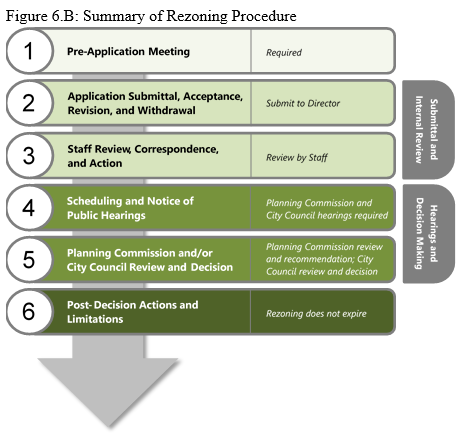
(A)
Pre-Application Meeting. A pre-application meeting shall be held in accordance with Subsection 11-6-3(b).
(B)
Application Submittal, Acceptance, Revisions, and Withdrawal. The rezoning application shall be submitted, accepted, and revised, and may be withdrawn, in accordance with Subsection 11-6-3(c). The application shall include all required information as indicated in the Administrative Manual and any additional information requested during the pre-application conference. When multiple parcels are proposed for rezoning, a separate application for each property shall be submitted pursuant to Subsection 11-6-3(c), unless the Director provides written approval for a consolidated application during the pre-application meeting.
(C)
Staff Review, Correspondence, and Action. The Director shall review the application and prepare a staff report and recommendation in accordance with Section 11-6-3(d).
(D)
Scheduling and Notice of Public Hearings.
(i)
The rezoning application shall be scheduled for public hearings before the Planning Commission and City Council, and noticed in accordance with Subsection 11-6-3(e).
(ii)
For City-initiated rezonings, affected property owners shall be notified by certified mail of the intended zoning change and public hearing(s) at least 15 days prior to the public hearing date.
(E)
Planning Commission and/or City Council Review and Decisions.
(i)
Planning Commission Review and Recommendation
(a)
The Planning Commission shall review the rezoning application and recommend approval, approval with conditions, or denial in accordance with Subsection 11-6-3(f) and the criteria in subsection (iii), below.
(b)
If the Planning Commission recommends denial, the Planning Commission shall communicate its reasons to City Council, and City Council shall have the power to overrule such recommendation for denial by a recorded vote of not less than three-fourths of its entire voting membership.
(ii)
City Council Review and Decision. The City Council shall review the rezoning application and act to approve, approve with conditions, or deny the rezoning in accordance with Subsection 11-6-3(f) and the criteria in subsection (iii), below.
(iii)
Rezoning Approval Criteria.
(a)
In reviewing a proposed rezoning, the Planning Commission and City Council shall consider whether:
(1)
The proposed rezoning is consistent with the Comprehensive Plan and the purposes of this UDO;
(2)
The rezoning is consistent with the purpose statement of the proposed zoning district;
(3)
There have been significant changes in the area to warrant a zoning change; The intensity of development in the new zoning district is not expected to create significantly adverse impacts to surrounding properties or the neighborhood; and
(4)
Public facilities and services are available to adequately serve the subject property while maintaining adequate level of service to existing development.
And/or:
(5)
There was an error in establishing the current zoning;
(b)
These approval criteria shall not apply to legislative rezonings by the City Council.
(iv)
Protest Procedure.
(a)
Any owner of property affected by a proposed rezoning may protest the rezoning pursuant to the statutory requirements of C.R.S. §31-23-305.
(b)
A protest against a rezoning shall be signed by the owners of at least 20 percent or more of the area of land included in the proposed zoning change or at least 20 percent of the area of land extending a radius of 100 feet from the land that is subject to the zoning change, excluding public rights-of-way.
(c)
In case of protest against a rezoning, approval shall require three-fourths of the entire voting membership of City Council prior to a rezoning becoming effective.
(F)
Post-Decision Actions and Limitations. Post-decision actions and limitations in Subsection 11-6-3(h) shall apply with the following modifications:
(i)
Following approval of a rezoning by City Council, the Director shall prepare an appropriate revision to the Official Zoning Map.
(ii)
Following approval of a rezoning, the Director shall record the amendment map and ordinance with the Adams County Clerk and Recorder as soon as practicable.
(b)
Rezoning to a Planned Development District.
(1)
Purpose. The boundaries of a zoning district or the zoning classification of any parcel may be changed to a Planned Development (PD) pursuant to this section. The PD district establishes standards specific to the proposed site that may provide an alternative or adjustment to the standards of this UDO. The purpose of rezoning to a PD is to achieve greater flexibility than allowed by the strict application of the UDO while providing greater benefit to the City. Rezoning to a PD district shall not be considered when a special use permit, variance, administrative adjustment, or rezoning to an existing base zoning district could achieve the same result.
(2)
Applicability. An application to rezone to a PD district may be submitted for any land within any combination of zoning districts. A PD district may be initiated by anyone owning land within the area affected by the proposed PD district.
(3)
Rezoning to a Planned Development District Procedure. Figure 6.C identifies the applicable steps from the common review procedures in Section 11-6-3 that apply to the review of Planned Development districts. Additions or modifications to the common review procedures are noted below.
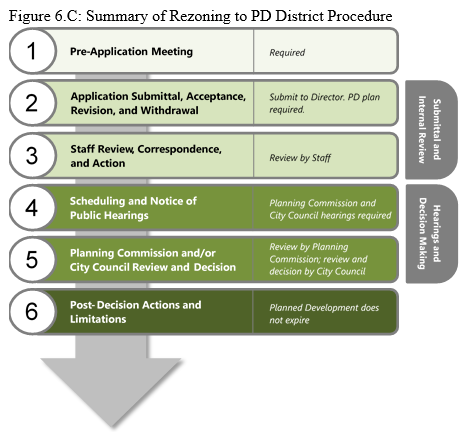
(A)
Pre-Application Meeting. A pre-application meeting shall be held in accordance with Subsection 11-6-3(b). In addition, the applicant shall provide the following conceptual materials related to the proposed PD district to help determine whether or not a PD district is the appropriate procedure for the applicant and the City:
(i)
Proposed uses;
(ii)
Number and type of dwelling units;
(iii)
Proposed parking capacity and configuration;
(iv)
Proposed modifications to underlying zoning district standards; and
(v)
General site planning layout and phasing.
(B)
Application Submittal, Acceptance, Revisions, and Withdrawal.
(i)
The PD district application shall be submitted, accepted, and revised, and may be withdrawn, in accordance with Subsection 11-6-3(c).
(ii)
An application for rezoning to a PD district shall include submittal requirements as specified by the Director, which shall include a PD plan. Approval of the PD plan is required prior to development in a PD district.
(iii)
The regulations of this UDO remain applicable to all PD development, except as specifically modified pursuant to the provisions contained in the approved PD plan.
(C)
Staff Review, Correspondence, and Action. The Director shall review the application and prepare a staff report and recommendation in accordance with Subsection 11-6-3(d).
(D)
Scheduling and Notice of Public Hearings. The PD district application shall be scheduled for public hearings before the Planning Commission and City Council and noticed in accordance with Subsection 11-6-3(e).
(E)
Planning Commission and/or City Council Review and Decisions.
(i)
Planning Commission Review and Recommendation. The Planning Commission shall review the PD district application and recommend approval, approval with conditions, or denial in accordance with Subsection 11-6-3(f).
(ii)
City Council Review and Decision.
(a)
The City Council shall review the PD district application and act to approve, approve with conditions, or deny the PD district in accordance with Subsection 11-6-3(f). The City Council may also remand the PD district application back to the Director or the Planning Commission for further consideration.
(b)
If council revises the amendment or remands the application back to the Director or Planning Commission, additional public hearings may be required before final adoption.
(iii)
PD District Approval Criteria. In reviewing a proposed rezoning to a PD district, the Planning Commission and City Council shall consider whether and to what extent the proposed PD district:
(a)
Meets the approval criteria for a general rezoning procedure, per Subsection (a)(3)(E)(iii);
(b)
Addresses a unique situation, provides substantial benefit to the City, or incorporates creative design, site layout, or configuration of uses such that it achieves the purposes of this UDO and represents an improvement in quality over what could have been accomplished through strict application of the otherwise applicable district or development standards;
(c)
Meets all applicable standards of this UDO not expressly modified in the PD district application; and
(d)
If the PD district provides residential uses, includes varied types of housing and densities to the maximum extent practicable.
(iv)
Approval of PD Plan. The approved PD district zoning and the approved PD plan along with all exhibits are inseparable, and a PD district shall not be established without the approval of the related PD plan. The approved PD district zoning, the approved PD plan, all exhibits, and any associated development agreement together establish the uses permitted, character of the development, and any approved modifications to the standards of the UDO.
(F)
Post-Decision Actions and Limitations. Post-decision actions and limitations in Subsection 11-6-3(h) shall apply with the following modifications:
(i)
Effect of Approval.
(a)
The regulations in this UDO remain applicable to all PD development unless expressly modified by an approved PD district rezoning. The zoning change shall not take effect until the PD plan, the zoning amendment map, and ordinance are recorded pursuant to Subsection 11-6-4(b)(3)(F)(iv).
(b)
Approval of a rezoning to a PD district reclassifies the zoning designation of the site and subjects it to the development regulations applicable to the underlying base zoning district and also any standards and conditions associated with the PD plan or development agreement approved as part of the PD district rezoning. Such approval does not itself authorize specific development activity.
(ii)
Expiration of a PD District. A PD district shall remain valid until a PD district is subsequently amended or rezoned to another zoning district in accordance with this UDO.
(iii)
Reconsideration after Five Years of No Development. If the applicant does not establish vested rights for a PD district pursuant to Subsection 11-6-7(c), and no development has occurred on the site in five years following the approval date of the PD district, the Director may initiate a public hearing process to consider whether the property shall be rezoned to its prior zoning classification or another zoning classification.
(iv)
Recording Required. Following approval of a PD district, the applicant shall submit final copies of the PD plans to the Director. The Director shall record the PD plan and the zoning amendment map and ordinance with the Adams County Clerk and Recorder as soon as practicable.
(v)
PD District Amendments.
(a)
Minor Amendments to an Approved PD District. Minor amendments to an approved PD district may be approved by the Director if the proposed amendment complies with the following criteria:
(1)
The amendment shall not change the overall character or intent of the development;
(2)
The amendment shall not change the ratio of residential units to square feet of non-residential space by more than 10 percent;
(3)
The amendment shall not change the allowed uses listed on the approved PD district;
(4)
The number of residential units to be constructed shall not be increased by more than 10 percent;
(5)
The gross square feet of non-residential space shall not be increased by more than 10 percent;
(6)
The number of vehicular access points to the site from public streets shall not be increased nor may the access points be relocated in such a way that negatively impacts public safety or the flow of traffic on the public streets;
(7)
The maximum allowable height of structures shall not be increased;
(8)
The setback distance to property lines shall not be reduced by more than 10 percent;
(9)
The amount of landscape shall not be reduced by more than 10 percent; and
(10)
The number of required parking spaces shall not be reduced by more than 10 percent unless in accordance with an overall reduction in the total square feet of non-residential space or residential units to be constructed.
(b)
Major Amendments to an Approved PD District
(1)
Unless a proposed amendment to a PD district meets the eligibility criteria for minor amendments in Subsection 11-6-4(b)(3)(F)(v)a above, all other PD amendments shall be deemed a major amendment and may only be amended by submitting an amended PD district pursuant to Subsection 11-6-3(h)(4).
(2)
If the Director determines that a minor amendment does not comply with the criteria in Subsection 11-6-4(b)(3)(F)(v)a, then the application can be forwarded on to the Planning Commission for review and the City Council for final decision as an amended PD district pursuant to Subsection 11-6-3(h)(4).
(vi)
Concurrent Subdivision Review.
(a)
Subdivision review required under Section 11-6-6 may be reviewed concurrently with PDs. A preliminary plat for a PD district shall only be approved following approval of the rezoning to PD district.
(b)
Each application for concurrent subdivision and PD district rezoning shall be reviewed and acted upon separately, based on the applicable standards and criteria in this UDO.
(c)
Unified Development Ordinance Amendment.
(1)
Purpose. This section describes the review and approval procedures for amending the text of this UDO to respond to changed conditions or changes in public policy, or to advance the general welfare of the City.
(2)
Applicability. An amendment to the text of this UDO shall be initiated by the Director, the Planning Commission, or the City Council.
(3)
Unified Development Ordinance Amendment Procedure. Figure 6.D identifies the applicable steps from the common review procedures in Section 11-6-3 that apply to the review of UDO amendments. Additions or modifications to those common review procedures are noted below.
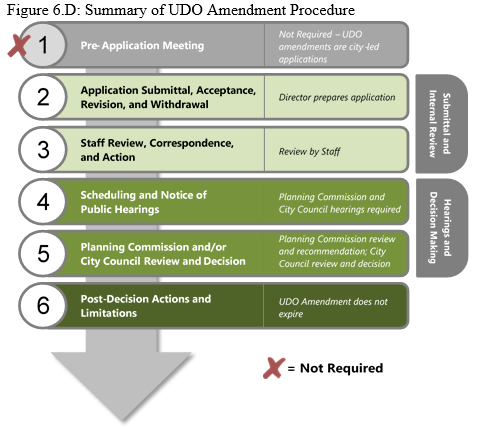
(A)
Application Submittal, Acceptance, Revisions, and Withdrawal. The UDO amendment application shall be submitted, accepted, and revised, and may be withdrawn, in accordance with Subsection 11-6-3(c). An application for an amendment to the UDO shall be prepared by the Director. If the amendment is initiated by the Planning Commission or City Council, the Director shall prepare the application at the request of the Planning Commission or City Council.
(B)
Staff Review, Correspondence, and Action. The Director shall review the application and prepare a staff report and recommendation in accordance with Subsection 11-6-3(d).
(C)
Scheduling and Notice of Public Hearings. The UDO amendment application shall be scheduled for public hearings before the Planning Commission and City Council, and noticed in accordance with Subsection 11-6-3(e).
(D)
Planning Commission and/or City Council Review and Decisions.
(i)
Planning Commission Review and Recommendation. The Planning Commission shall review the UDO amendment application and recommend approval, approval with conditions, or denial of the amendment in accordance with Subsection 11-6-3(f).
(ii)
City Council Review and Decision.
(a)
The City Council shall review the UDO amendment application and approve, approve with conditions, or deny the amendment in accordance with Subsection 6.3.6. The City Council may also remand the application back to the Director or the Planning Commission for further consideration.
(b)
If council revises the amendment or remands the application back to the Director or Planning Commission, additional public hearings may be required before final adoption.
(iii)
UDO Amendment Approval Criteria. A UDO amendment is a legislative decision by the City Council. Prior to recommending approval or approving a proposed UDO amendment, the Planning Commission and City Council shall consider whether and to what extent that the proposed amendment:
(a)
Is consistent with the Comprehensive Plan;
(b)
Does not conflict with other provisions of this UDO or other provisions in the Northglenn Municipal Code;
(c)
Is necessary to address a demonstrated community need;
(d)
Is necessary to respond to changing conditions or policy; and
(e)
Is consistent with the purpose and intent of the zoning districts in the UDO, would improve compatibility among land uses within the City, or would result in an orderly and logical development pattern.
(E)
Post-Decision Actions and Limitations. Post-decision actions and limitations in Subsection 11-6-3(h) shall apply with the following modifications:
(i)
Approval of a UDO amendment authorizes the approved revision to the text. A UDO amendment does not authorize specific development activity.
(ii)
A UDO amendment shall remain valid until the revised text of the UDO is subsequently amended in accordance with this section.
[Source: Ord. 1766, 2019]
Section 11-6-5. Development Permits.
(a)
Site Plan Review.
(1)
Purpose. The site plan review procedure is intended to provide a process by which development is reviewed for compliance with the development and design standards of this UDO. The site plan review procedure ensures that the City has an opportunity to mitigate potential impacts of development prior to issuance of a building permit.
(2)
Applicability.
(A)
Exemptions.
(i)
The following development is exempt from the site plan review procedure:
(a)
A change in use that does not involve or require other development (such as new or expanded structures, additional parking, etc.);
(b)
Tenant improvements that do not increase gross floor area or building height, increase the density or intensity of use, or affect parking or landscaping requirements; and
(c)
Construction of single-family detached dwellings or duplex dwellings not to exceed nine dwelling units, additions to such dwellings, and structures accessory to such dwellings.
(ii)
Developments exempt from the site plan review procedure may be required to demonstrate compliance with the standards in this Code prior to issuance of a building permit.
(B)
Major Site Plan. Major site plan approval is required for any of the following development, unless exempted from site plan approval under subparagraph (A) above.
(i)
New development or the expansion of existing development requiring 10 or more new or added dwelling units;
(ii)
New development on a parcel larger than five acres;
(iii)
New development requiring 30 or more new or added vehicle parking spaces;
(iv)
Any single use or combination of uses proposed in a structure that is more than 10,000 square feet in building size, or multiple buildings totaling more than 10,000 square feet, not including single-family detached or duplex dwellings; or
(v)
Any minor site plan determined by the Director to require major site plan review.
(C)
Minor Site Plan. Minor site plan approval is required for any development not meeting the requirements set forth in subparagraph (B) above, unless exempted from site plan approval under subparagraph (A) above.
(D)
Concurrent Review.
(i)
An application for site plan approval may be submitted and reviewed concurrently with an application for a special use permit or an administrative adjustment. In such a case, the Director or Planning Commission shall not decide the site plan approval application until after the special use permit or administrative adjustment is approved.
(ii)
An application for site plan approval may be submitted and reviewed concurrently with an application for a subdivision plat. In such a case, the Director or Planning Commission shall not decide the site plan approval application until after the plat is approved.
(3)
Major Site Plan Procedure. Figure 6.E identifies the applicable steps from the common review procedures in Section 11-6-3 that apply to the review of major site plans. Additions or modifications to the common review procedures are noted below.
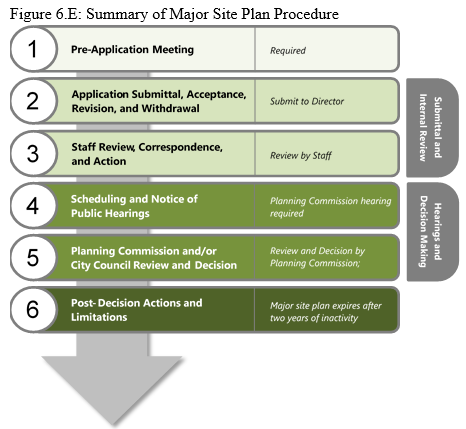
(A)
Pre-Application Meeting. A pre-application meeting shall be held in accordance with Subsection 11-6-3(b).
(B)
Application Submittal, Acceptance, Revision, and Withdrawal.
(i)
The major site plan application shall be submitted, accepted, and revised, and may be withdrawn, in accordance with Subsection 11-6-3(c). The application shall include all required information as indicated in the Administrative Manual and any additional information requested during the pre-application meeting.
(ii)
The Director or the Planning Commission may require at any stage of review of any site plan, submission of any plan, study, survey or other information, in addition to that specified in this article or the Administrative Manual, and at the applicant's expense, as determined necessary to enable review, recommendation, and/or approval of the site plan.
(C)
Staff Review, Correspondence, and Action. The Director shall review the major site plan application and prepare a staff report and recommendation in accordance with Subsection 11-6-3(d).
(D)
Scheduling and Notice of Public Hearings. The major site plan application shall be scheduled for a public hearing before the Planning Commission, and noticed in accordance with Subsection 11-6-3(e).
(E)
Planning Commission and/or City Council Review and Decision.
(i)
Planning Commission Review and Decision. The Planning Commission shall review the major site plan application and approve, approve with conditions, or deny of the major site plan in accordance with Subsection 11-6-3(f). The Planning Commission may also remand the application back to the Director for further consideration.
(ii)
Major Site Plan Approval Criteria. In reviewing a proposed major site plan application, the Planning Commission shall consider whether:
(a)
The site plan complies with applicable standards in this UDO, including Article 2, Zoning Districts; Article 3, Use Regulations; Article 4, Development Standards; and any other applicable standards of this UDO.
(b)
The site plan is consistent with any previously approved plat, Planned Development, or any other precedent land use approval; and
(c)
The site plan is consistent with the Comprehensive Plan and other adopted City policies and plans.
(F)
Post-Decision Actions and Limitations. Post-decision actions and limitations in Subsection 11-6-3(h) shall apply, with the following modifications:
(i)
No Building Permit without Approval. No building permit shall be issued until the major site plan has been approved pursuant to this article.
(ii)
Expiration of Approval. Site plan approval shall expire if the authorized use or construction is not substantially underway within two years after the date of the major site plan approval, or an extension is granted pursuant to Subsection 11-6-3(h)(3)(C).
(iii)
Minor Changes Allowed. Development applications authorized by a major site plan approval may incorporate minor changes from the approved site plan without the need for a new application (as required by Subsection 11-6-3(h)(4)), provided that the Director determines that the proposed changes:
(a)
Could be approved under the allowable administrative adjustments in Table 6.C, Allowable Administrative Adjustments, if they were proposed in a new application;
(b)
Continue to comply with the standards of this UDO;
(c)
Are necessary to meet conditions of approval of the Major Site Plan application; and/or
(d)
Would not significantly alter the function, form, intensity, character, demand on public facilities, or impact on adjacent properties as approved with the major site plan.
(iv)
Appeal to City Council. The decision on a major site plan may be appealed to the City Council in accordance with Subsection 11-6-7(d), Appeal.
(4)
Minor Site Plan Procedure. Figure 6.F identifies the applicable steps from the common review procedures in Section 11-6-3 that apply to the review of minor site plans. Additions or modifications to the common review procedures are noted below.
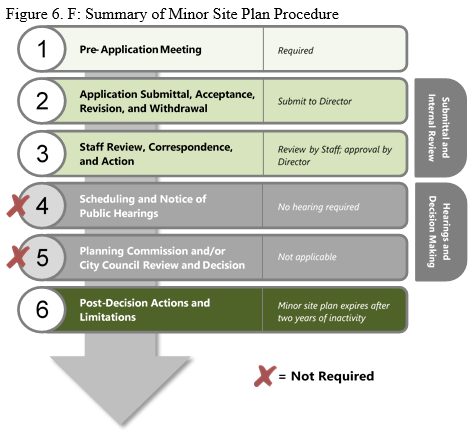
(A)
Pre-Application Meeting. A pre-application meeting shall be held in accordance with Subsection 11-6-3(b).
(B)
Application Submittal, Acceptance, Revisions, and Withdrawal. A complete minor site plan application shall be submitted to the Director in accordance with Subsection 11-6-3(c). The application shall include all required information as indicated in the Administrative Manual and any additional information requested during the pre-application meeting.
(C)
Staff Review, Correspondence, and Action.
(i)
Review and Decision. The Director shall review the minor site plan application according to the criteria below and approve, approve with conditions, or deny the minor site plan. The Director may also refer the minor site plan to Planning Commission and/or City Council for recommendation and approval using the major site plan review procedure.
(ii)
Minor Site Plan Approval Criteria. In reviewing a proposed minor site plan application, the Director shall consider whether:
(a)
The site plan complies with applicable standards in this UDO, including Article 2, Zoning Districts; Article 3, Use Regulations; Article 4, Development Standards; and any other applicable standards of this UDO.
(b)
The site plan is consistent with any previously approved plat, Planned Development, or any other precedent land use approval; and
(c)
The site plan is consistent with the Comprehensive Plan and other adopted City policies and plans.
(D)
Post-Decision Actions and Limitations. Post-decision actions and limitations in Subsection 11-6-3(h) shall apply, with the following modifications:
(i)
No Building Permit without Approval. No building permit shall be issued until the major site plan has been approved pursuant to this article.
(ii)
Expiration of Approval. Site plan approval shall expire if the authorized use or construction is not substantially underway within two years after the date of the major site plan approval, or an extension is granted pursuant to Subsection 11-6-3(h)(3)(C).
(iii)
Minor Changes Allowed. The Director may approve minor changes to an approved site plan without requiring a new application (as required by Subsection 11-6-3(h)(4)), provided that the Director determines that the proposed changes:
(a)
Could be approved under the allowable administrative adjustments in Table 6.C, Allowable Administrative Adjustments, if they were proposed in a new application;
(b)
Continue to comply with the standards of this UDO;
(c)
Are necessary to meet conditions of approval of the Minor Site Plan application; and/or
(d)
Would not significantly alter the function, form, intensity, character, demand on public facilities, or impact on adjacent properties as approved with the minor site plan.
(iv)
Appeal to Planning Commission. The decision on a minor site plan may be appealed to the Planning Commission in accordance with Subsection 11-6-7(d), Appeal.
(b)
Special Use Permit.
(1)
Purpose. This special use permit procedure provides a mechanism for the City to evaluate proposed development and land uses that have unique or widely varying operating characteristics or unusual site development features to ensure compatibility with surrounding areas and the goals of the Comprehensive Plan and this UDO. This procedure is intended to evaluate the potential impacts of such uses on surrounding properties and to ensure that such uses are compatible with surrounding properties and that adequate mitigation is provided to minimize potential impacts on those surrounding properties and/or the greater community.
(2)
Applicability. A special use permit is required for certain land uses and zoning districts as specified in Table 3-2 A, Table of Allowed Uses.
(3)
Special Use Permit Procedure. Figure 6.G identifies the applicable steps from the common review procedures in Section 11-6-3 that apply to the review of special use permit applications. Additions or modifications to the common review procedures are noted below.
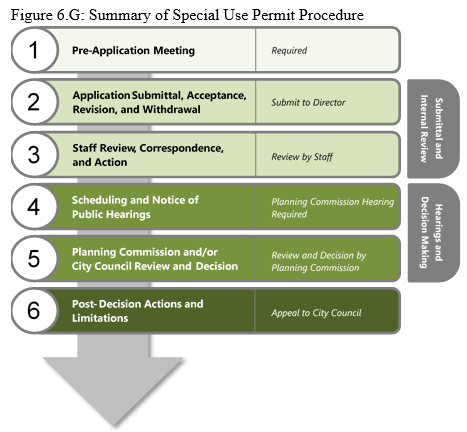
(A)
Pre-Application Meeting. A pre-application meeting shall be held in accordance with Subsection 11-6-3(b).
(B)
Application Submittal, Acceptance, Revisions, and Withdrawal.
(i)
The special use permit application shall be submitted, accepted, and revised, and may be withdrawn, in accordance with Subsection 11-6-3(c). The application shall include all required information as indicated in the Administrative Manual and any additional information requested during the pre-application meeting.
(ii)
Special use permit applications shall also include the following:
(a)
Plans showing the location of all existing and proposed buildings, architectural elevations of such buildings, parking areas, ingresses and egresses, drainage facilities, waste disposal areas, and landscape;
(b)
A description of the proposed use and operation in sufficient detail to indicate the effect of operation in producing air pollution, water pollution, odor, noise, glare, fire danger, other safety hazards, and traffic congestion;
(c)
Mitigation of any public utility impacts; and
(d)
Information on the proposed number of shifts to be worked and the maximum number of employees.
(C)
Staff Review, Correspondence, and Action. The Director shall review the special use permit application and prepare a staff report and recommendation in accordance with Subsection 11-6-3(d).
(D)
Scheduling and Notice of Public Hearings. The special use permit application shall be scheduled for a public hearing before the Planning Commission, and noticed in accordance with Subsection 11-6-3(e).
(E)
Planning Commission Review and Action.
(i)
Special Use Permit Review. The Planning Commission shall review and approve, approve with conditions, or deny the special use permit application in accordance with Subsection 11-6-3(f). The Planning Commission may also remand the application back to the Director for further consideration.
(ii)
Special Use Permit Approval Criteria. In reviewing a proposed special use, the Planning Commission shall consider whether:
(a)
The use is compatible with the surrounding area;
(b)
The use has minimal impacts on future development of the area;
(c)
The use meets all other standards of the UDO and all other applicable codes;
(d)
Adequate mitigation of any impacts associated with access, traffic, emergency services, utilities, parking, refuse areas, noise, glare, and odor have been provided;
(e)
The use is in conformance with the Comprehensive Plan;
(f)
The use is consistent with any applicable Urban Renewal Plan; and
(g)
The use adversely impacts the health, safety, and welfare of the inhabitants of the area and the City of Northglenn.
(F)
Post-Decision Actions and Limitations. Post-decision actions and limitations in Subsection 11-6-3(h) shall apply, with the following modifications:
(i)
Expiration of a Special Use Permit. Unless substantially acted upon within two years following the date of approval, a special use permit shall automatically expire. This shall include demonstrated use of the property, construction, or some other measureable development activity.
(ii)
Permit Cancellation. The Planning Commission may cancel permits for violation of any regulations of the City of Northglenn or conditions imposed by the Planning Commission. Prior to cancellation, the Commission shall provide written notice to the permittee at least 30 days prior to the scheduled public hearing at the address contained in the permit. The notice shall describe the allegation of the violation and directing the permittee to appear at a public hearing to discuss the nature and extent of the alleged violation. Following the public hearing, the Planning Commission may cancel or revoke the permit issued to the permittee, require corrective measures to be taken, or direct the City to enter onto the premises and take corrective measures required by the Commission. Costs of such corrective measures shall be assessed to the permittee.
(iii)
Expansion or Enlargement.
(a)
Any expansion or enlargement of a special use shall require a new application.
(b)
Expansions or enlargements may be approved by the Director provided that:
(1)
The expansion or enlargement is not expected to increase potential negative impacts to surrounding property or the City; and
(2)
The expansion or enlargement will not require adjustments to any standards greater than allowed through the administrative adjustment procedures in Subsection 11-6-7(b).
(c)
Any expansion or enlargement of a special use that does not meeting the criteria for Director approval shall require approval by the Planning Commission.
(iv)
Transfer of Special Use Permit. A special use permit may be transferred to another person to operate the same use, in the same building(s), on the same property, and under the same terms of the permit. Such transfer shall require approval of a written request to the Director.
(v)
Appeal to City Council. The decision on a special use permit may be appealed to the City Council in accordance with Subsection 11-6-7(d), Appeal.
(c)
Temporary Use Permit.
(1)
Purpose. The temporary use procedure provides a mechanism for the City to evaluate prospective uses and/or structures on private property of limited duration to ensure compliance with applicable standards of this UDO, including Section 11-3-3, Use-Specific Standards.
(2)
Applicability. A temporary use permit is required before establishing, constructing, or installing any temporary use or structure pursuant to Section 11-3-5, Temporary Uses and Structures.
(3)
Temporary Use Permit Procedure. Figure 6.H identifies the applicable steps from the common review procedures in Section 11-6-3 that apply to the review of temporary use permits. Additions or modifications to the common review procedures are noted below.
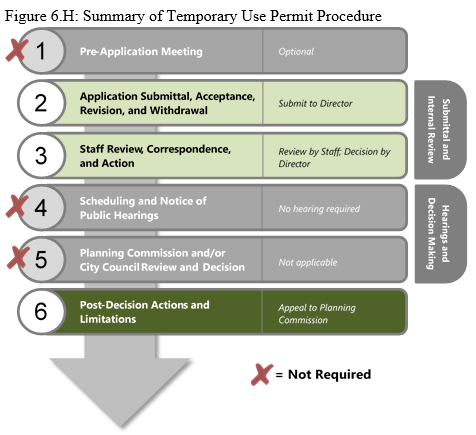
(A)
Pre-Application Meeting. An optional pre-application meeting may be held in accordance with Subsection 11-6-3(b) at the applicant's discretion.
(B)
Application Submittal, Acceptance, Revisions, and Withdrawal. A complete temporary use permit application shall be submitted to the Director in accordance with Subsection 11-6-3(c). The application shall include all required information as indicated in the Administrative Manual, and any additional information requested by the Director.
(C)
Staff Review, Correspondence, and Action.
(i)
Review and Decision. The Director shall review the temporary use permit application according to the criteria below and the Director shall approve, approve with conditions, or deny the permit. The Director may refer a temporary use permit application to the Planning Commission for evaluation and final decision.
(ii)
Temporary Use Permit Approval Criteria. In reviewing a temporary use or structure, the Director, or Planning Commission for referred applications, shall consider whether the proposed use or structure:
(a)
Is consistent with the Comprehensive Plan;
(b)
Complies with applicable temporary use standards, as well as all other applicable standards in this UDO;
(c)
Adequately mitigates any impacts associated with access, traffic, emergency services, utilities, parking, refuse areas, noise, glare, and odor; and
(d)
Complies with all requirements and conditions of approval of any prior development permits or approvals.
(D)
Post-Decision Actions and Limitations. Post-decision actions and limitations in Subsection 11-6-3(h) shall apply, with the following modifications:
(i)
Effect of Approval. A temporary use permit authorizes establishment, construction, or installation of the approved temporary use or structure in accordance with the terms and conditions of the permit.
(ii)
Expiration of Approval. A temporary use permit shall be valid beginning on the date specified on the permit and shall remain valid for the time period indicated on the permit. Upon request, the Director may grant a one-year extension; however, in no case shall a temporary use permit be valid for more than one year after its original expiration date. This one-year extension period may not be further extended. Any temporary use permit requesting an approval period beyond one year shall require a special use permit approval pursuant to Subsection (b).
(iii)
Removal and Restoration. Before the expiration of a temporary use permit, the permittee shall disconnect all temporary uses and structures, and associated property and equipment, and free the temporary use site from all trash, litter, and debris to the satisfaction of the Director.
(iv)
Appeal to the Planning Commission. The applicant may appeal the denial, revocation, or suspension of a temporary use permit to the Planning Commission in accordance with Subsection 11-6-7(d), Appeal.
(d)
Change of Use Permit.
(1)
Purpose. The change of use permit procedure provides a mechanism for the City to evaluate new uses of properties and/or buildings, and/or change in occupancy due to change of ownership or tenancy to ensure compliance with applicable standards of this UDO.
(2)
Applicability. A change of use permit is required before the following activities:
(A)
Occupying or using vacant land;
(B)
Occupying a vacant building;
(C)
Changing the use of a property or building; and/or
(D)
Changing occupancy of a property or building.
(3)
Change of Use Permit Procedure. Figure 6.I identifies the applicable steps from the common review procedures in Section 11-6-3 that apply to the review of change of use permits. Additions or modifications to the common review procedures are noted below.
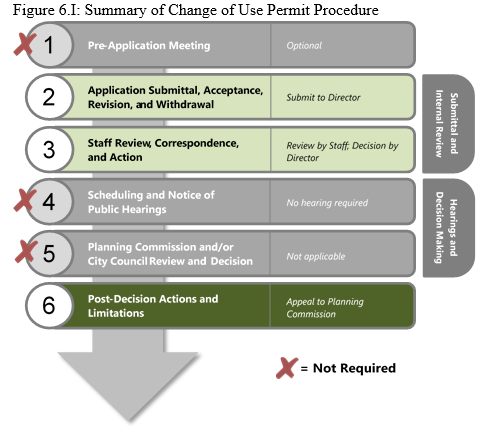
(A)
Pre-Application Meeting. An optional pre-application meeting may be held in accordance with Subsection 11-6-3(b) at the applicant's discretion.
(B)
Application Submittal, Acceptance, Revisions, and Withdrawal. A complete change of use permit application shall be submitted to the Director in accordance with Subsection 11-6-3(c). The application shall include all required information as indicated in the Administrative Manual, and any additional information requested by the Director.
(C)
Staff Review, Correspondence, and Action.
(i)
Review and Decision. The Director shall review the change of use permit application according to the criteria below and the Director shall approve, approve with conditions, or deny the permit.
(ii)
Change of Use Permit Approval Criteria. In reviewing a change of use on a parcel or within a building, the Director shall consider whether the proposed change of use:
(a)
Is consistent with the Comprehensive Plan;
(b)
Complies with applicable use-specific standards, as well as all other applicable standards in this UDO;
(c)
Adequately mitigates any impacts associated with access, traffic, emergency services, utilities, parking, refuse areas, noise, glare, and odor; and
(d)
Complies with all requirements and conditions of approval of any prior development permits or approvals.
(D)
Post-Decision Actions and Limitations. Post-decision actions and limitations in Subsection 11-6-3(h) shall apply, with the following modifications:
(i)
Effect of Approval. A change of use permit authorizes establishment of a new use and/or change of occupancy of an existing property or building with any additional terms and conditions of the permit. The change of use permit shall clearly state that the proposed use of a building or property complies with the provisions of this UDO. For any proposed change of use or occupancy requiring a building permit, a change of use permit shall be issued prior to issuing a certificate of occupancy or a temporary certificate of occupancy.
(ii)
Revocation of a Change of Use Permit. A change of use permit may be revoked by the Director if the use of the property or building is inconsistent with the authorized use of the change of use permit. The Director shall notify the permit holder in writing and provide 30 days from the date of the letter for the permit holder to bring the use of the property into compliance with the change of use permit, or the permit shall be revoked.
(iii)
Appeal to the Planning Commission. The applicant may appeal the denial, revocation, or suspension of a change of use permit to the Planning Commission in accordance with Subsection 11-6-7(d), Appeal.
[Source: Ord. 1766, 2019]
Section 11-6-6. Subdivision Procedures.
(a)
Minor Subdivision.
(1)
Purpose. The minor subdivision procedure is used to evaluate proposed subdivisions that will create few lots and/or involve minimal adjustments to approved final plats. The minor subdivision procedure also provides a mechanism for administrative platting decisions, to address plat errors, and to apply minor adjustments to property boundaries when necessary.
(2)
Applicability.
(A)
The minor subdivision procedure shall apply to applications meeting the following:
(i)
Subdivisions of properties within an approved preliminary plat creating three or fewer lots and containing fewer than five acres;
(ii)
Subdivisions creating three or fewer lots and containing less than two acres with or without an approved preliminary plat;
(iii)
Consolidation of two or more lots into a single lot in a previously recorded final plat; or
(iv)
Boundary or lot line adjustments to an approved final plat; or
(v)
Correction of errors on an approved final plat.
(3)
Minor Subdivision Procedure. Figure 6.J identifies the applicable steps from the common review procedures in Section 11-6-3 that apply to the review of minor subdivisions. Additions or modifications to the common review procedures are noted below.
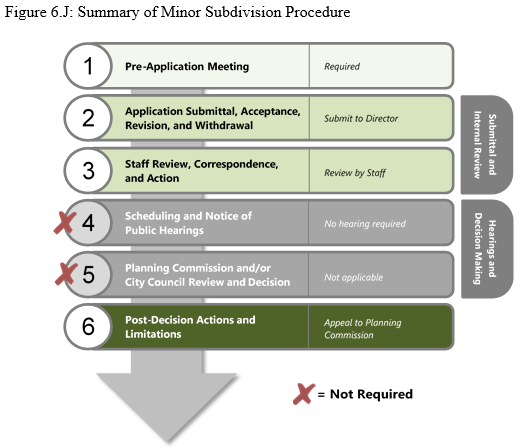
(A)
Pre-Application Meeting. A pre-application meeting shall be held in accordance with Subsection 11-6-3(b).
(B)
Application Submittal, Acceptance, Revisions, and Withdrawal. A complete minor subdivision application shall be submitted to the Director in accordance with Subsection 11-6-3(c). The application shall include all required information as indicated in the Administrative Manual and any additional information requested by the Director or during the pre-application meeting.
(C)
Staff Review, Correspondence, and Action.
(i)
Review and Decision. The Director shall review the minor subdivision application and the Director shall approve, approve with conditions, or deny the minor subdivision based on the criteria below.
(ii)
Minor Subdivision Approval Criteria. In reviewing a minor subdivision application, the Director shall consider whether the minor subdivision:
(a)
Is consistent with the Comprehensive Plan;
(b)
Is consistent with the intent of the underlying zoning district;
(c)
Complies with applicable dimensional, development, and design standards in this UDO;
(d)
Does not affect a recorded easement without approval from the easement holder;
(e)
Will not result in adverse impacts to surrounding property; and
(f)
Will not limit the City's ability to provide adequate and sufficient facilities or services.
(iii)
Appeal to Planning Commission. The decision on a minor subdivision may be appealed to the Planning Commission in accordance with Subsection 11-6-7(d), Appeal.
(D)
Post-Decision Actions and Limitations. Post-decision actions and limitations in Subsection 11-6-3(h) shall apply, and the City shall record minor subdivisions with the County Clerk within 30 days of approval by the Director.
(b)
Preliminary Plat.
(1)
Purpose. The procedure for review and approval of preliminary plats is a mechanism for the City to review an overall plan for a proposed subdivision to ensure compliance with this UDO and the Comprehensive Plan.
(2)
Applicability. A preliminary plat is required when one or more of the following conditions exist:
(A)
The proposed subdivision will produce four or more lots;
(B)
The proposed subdivision will include the dedication of public right-of-way, other public tracts, or public improvements not determined to be eligible for minor subdivision processing; or
(C)
The proposed subdivision is not otherwise eligible to be processed as a minor subdivision, pursuant to Subsection (a).
(3)
Preliminary Plat Procedure. Figure 6.K identifies the applicable steps from the common review procedures in Section 11-6-3 that apply to the review of preliminary plats. Additions or modifications to the common review procedures are noted below.
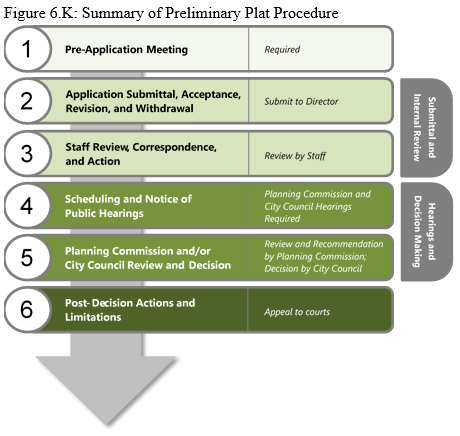
(A)
Pre-Application Meeting. A pre-application meeting shall be held in accordance with Subsection 11-6-3(b).
(B)
Application Submittal, Acceptance, Revisions, and Withdrawal. The preliminary plat application shall be submitted, accepted, and revised, and may be withdrawn, in accordance with Subsection 11-6-3(c). The application shall include all required information as indicated in the Administrative Manual and any additional information requested during the pre-application meeting. The preliminary plat shall reflect the general layout of the lots and blocks, but exact dimensions are not required.
(C)
Staff Review, Correspondence, and Action. The Director shall review the preliminary plat application and prepare a staff report and recommendation in accordance with Subsection 11-6-3(d).
(D)
Scheduling and Notice of Public Hearings. The preliminary plat application shall be scheduled for public hearings before the Planning Commission and City Council, and noticed in accordance with Subsection 11-6-3(e).
(E)
Planning Commission and/or City Council Review and Action.
(i)
Planning Commission Review and Recommendation. The Planning Commission shall review the preliminary plat application and recommend approval, approval with conditions, or denial in accordance with Subsection 11-6-3(f).
(ii)
City Council Review and Decision.
(a)
The City Council shall review the preliminary plat application and act to approve, approve with conditions, or deny the preliminary plat in accordance with Subsection 11-6-3(f). The City Council may also remand the preliminary plat application back to the Director or the Planning Commission for further consideration.
(b)
If council revises the preliminary plat or remands the application back to the Director or Planning Commission, additional public hearings may be required before final adoption.
(iii)
Conditions of Approval. If the preliminary plat is approved with conditions, then those conditions and the standards of this UDO shall be met prior to approval of a final plat.
(iv)
Preliminary Plat Approval Criteria. In reviewing a preliminary plat application, the Planning Commission and City Council shall consider whether the preliminary plat:
(a)
Is in conformance with the Comprehensive Plan;
(b)
Will comply with the applicable zoning district standards;
(c)
Will comply with use, dimensional, design, and other development standards in this UDO;
(d)
Provides a layout of lots, roads, driveways, utilities, drainage, and other public facilities and services designed to minimize the amount of disturbance to sensitive natural areas or other community resources;
(e)
Provides evidence of public water and sewer system connections;
(f)
Identifies and adequately mitigates known natural hazard areas; and
(g)
Proposes reasonable project phasing in terms of infrastructure capacity.
(F)
Post-Decision Actions and Limitations. Post-decision actions and limitations in Subsection 11-6-3(h) shall apply, with the following modifications:
(i)
Expiration of Approval. Any approval or conditional approval of a preliminary plat shall automatically expire if a final plat has not been recorded within two years of preliminary plat approval. The Planning Commission shall have authority to extend the period for not more than 12 months, on the basis of unforeseen circumstances. Application for an extension of time shall be made to the Director, which shall forward the application, together with its recommendations, to the Planning Commission for action at any regular or special meeting, on notice to the applicant.
(ii)
Partial or Phased Final Platting.
(a)
All or any portion of an approved preliminary plat may be submitted for final plat pursuant to Subsection (c). In the case of partial submission, the time for submission of the remaining portion of the preliminary plat is automatically extended for two years from the approval date of that partial final plat.
(b)
Whenever a preliminary plat is approved for development of the subdivision in successive phases or increments, the City Council may provide the period or periods of time allowed for final plat approval of each successive phase or increment of the development after the first.
(c)
Final Plat.
(1)
Purpose. The final plat procedure completes the subdivision process and ensures compliance with the approved preliminary plat and all applicable standards in this UDO.
(2)
Applicability. The final plat procedure applies to all subdivisions in the City of Northglenn unless stated otherwise in this UDO.
(3)
Final Plat Procedure -- Not Requiring Public Infrastructure Improvements or Subdivision Improvement Agreement (SIA). Figure 6.L identifies the applicable steps from the common review procedures in Section 11-6-3 that apply to the review of final plats without public infrastructure or SIA requirements. Additions or modifications to the common review procedures are noted below.
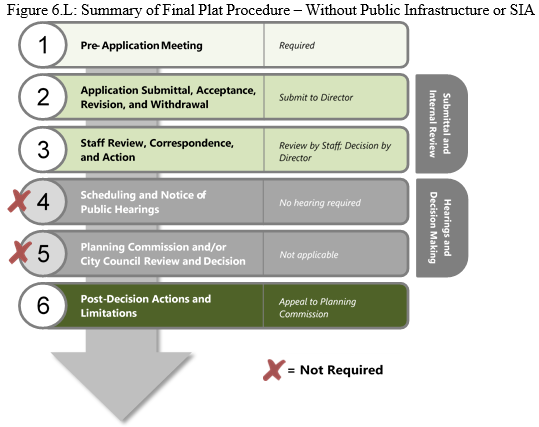
(A)
Pre-Application Meeting. A pre-application meeting shall be held in accordance with Subsection 11-6-3(b).
(B)
Application Submittal, Acceptance, Revisions, and Withdrawal. The final plat application shall be submitted, accepted, and revised, and may be withdrawn, in accordance with Subsection 11-6-3(c).
The application shall include all required information as indicated in the Administrative Manual and any additional information requested during the pre-application meeting. Additionally:
(i)
The final plat application shall be submitted within two years of preliminary plat approval.
(ii)
If any lot changes have occurred since preliminary plat approval, the application shall be referred back to the Director and distributed to the appropriate utility providers for review and comment.
(iii)
The final plat may reflect the entire preliminary plat or any portion of the preliminary plat.
(C)
Staff Review, Correspondence, and Action.
(i)
Director Review and Approval. The Director shall review the final plat application and shall approve, approve with conditions, or deny the final plat based on the criteria below.
(ii)
Final Plat Approval Criteria. In reviewing a final plat application, the Director shall consider whether:
(a)
The final plat conforms to the approved preliminary plat, including any conditions of approval;
(b)
The development will substantially comply with all requirements of this UDO; and
(c)
The development will comply with the applicable technical standards and specifications adopted by the City.
(D)
Post-Decision Actions and Limitations. Post-decision actions and limitations in Subsection 11-6-3(h) shall apply, with the following modifications:
(i)
Acceptance and Signatures. Following final plat approval, the plat shall be signed by the Mayor and acknowledged by the City Clerk. Approval of the final plat shall include and constitute acceptance of all proposed dedications contained in the plat by the City of Northglenn.
(ii)
Posting Security and Recordation. The City shall record the final plat with the County Clerk within 30 days of approval, but not before security for public infrastructure or other improvements has been posted pursuant to Section 11-5-6. If security for such improvements is not posted within 30 days following final plat approval, the approval shall lapse.
(iii)
Appeal to the Planning Commission. The decision on a final plat may be appealed to the Planning Commission in accordance with Subsection 11-6-7(d), Appeal.
(4)
Final Plat Procedure -- Requiring Public Infrastructure Improvements or Subdivision Improvement Agreement (SIA). Figure 6.M identifies the applicable steps from the common review procedures in Section 11-6-3 that apply to the review of final plats requiring public infrastructure or an SIA. Additions or modifications to the common review procedures are noted below.
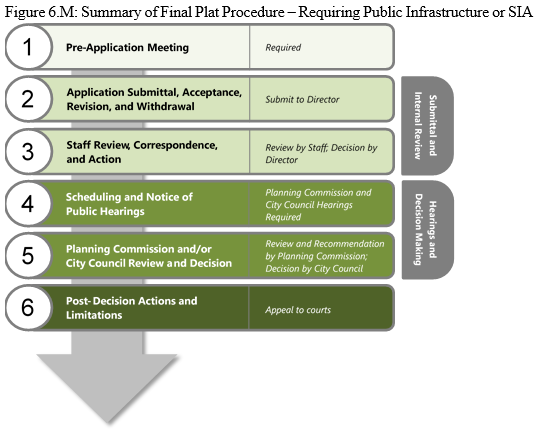
(A)
Pre-Application Meeting. A pre-application meeting shall be held in accordance with Subsection 11-6-3(b).
(B)
Application Submittal, Acceptance, Revisions, and Withdrawal. The final plat application shall be submitted, accepted, and revised, and may be withdrawn, in accordance with Subsection 11-6-3(c). The application shall include all required information as indicated in the Administrative Manual and any additional information requested during the pre-application meeting. Additionally:
(i)
The final plat application shall be submitted within two years of preliminary plat approval.
(ii)
If any lot changes have occurred since preliminary plat approval, the application shall be referred back to the Director and distributed to the appropriate utility providers for review and comment.
(iii)
The final plat may reflect the entire preliminary plat or any portion of the preliminary plat.
(C)
Staff Review, Correspondence, and Action. The Director shall review the final plat application and prepare a staff report and recommendation in accordance with Subsection 11-6-3(d).
(D)
Scheduling and Notice of Public Hearings. The final plat application shall be scheduled for public hearings before the Planning Commission and City Council, and noticed in accordance with Subsection 11-6-3(e).
(E)
Planning Commission and/or City Council Review and Action.
(i)
Planning Commission Review and Recommendation. The Planning Commission shall review the final plat application and recommend approval, approval with conditions, or denial in accordance with Subsection 11-6-3(f).
(ii)
City Council Review and Decision.
(a)
The City Council shall review the final plat application and act to approve, approve with conditions, or deny the final plat in accordance with Subsection 11-6-3(f). The City Council may also remand the final plat application back to the Director or the Planning Commission for further consideration.
(b)
If council revises the final plat or remands the application back to the Director or Planning Commission, additional public hearings may be required before final approval.
(iii)
Final Plat Approval Criteria. In reviewing a final plat application, the Director shall consider whether:
(a)
The final plat conforms to the approved preliminary plat, including any conditions of approval;
(b)
The development will substantially comply with all requirements of this UDO; and
(c)
The development will comply with the applicable technical standards and specifications adopted by the City.
(F)
Post-Decision Actions and Limitations. Post-decision actions and limitations in Subsection 11-6-3(h) shall apply, with the following modifications:
(i)
Acceptance and Signatures. Following final plat approval, the plat shall be signed by the Mayor and acknowledged by the City Clerk. Approval of the final plat shall include and constitute acceptance of all proposed dedications contained in the plat by the City of Northglenn.
(ii)
Posting Security and Recordation. The City shall record the final plat with the County Clerk within 30 days of approval, but not before security for public infrastructure or other improvements has been posted pursuant to Section 11-5-6. If security for such improvements is not posted within 30 days following final plat approval, the approval shall lapse.
(d)
Vacation of Right-of-Way or Easements.
(1)
Purpose. This section describes the procedure for vacating rights, interests, or title of the City in and to any right-of-way or easement located in the City of Northglenn. Title to vacated roadways shall be in accordance with Colorado law.
(2)
Applicability. This procedure applies to any request to vacate rights, interests, or title of right-of-way or an easement within the City of Northglenn.
(3)
Vacation Procedure. Figure 6.N identifies the applicable steps from the common review procedures in Section 11-6-3 that apply to the review of vacations of right-of-way or easements. Additions or modifications to the common review procedures are noted below.
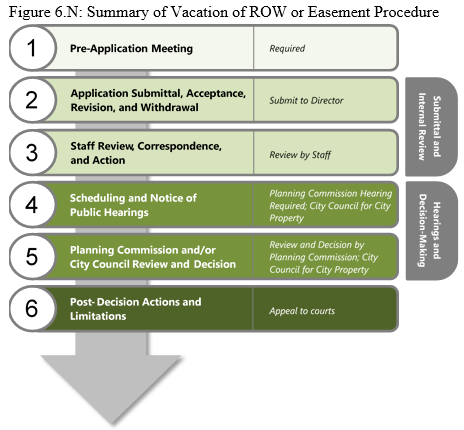
(A)
Pre-Application Meeting. A pre-application meeting shall be held in accordance with Subsection 11-6-3(b).
(B)
Application Submittal, Acceptance, Revisions, and Withdrawal.
(i)
The vacation application shall be submitted, accepted, and revised, and may be withdrawn, in accordance with Subsection 11-6-3(c). The application shall include all required information as indicated in the Administrative Manual and any additional information requested during the pre-application meeting.
(ii)
Additionally, the application for a vacation shall be accompanied by a map or plat showing the location and dimension of the area to be vacated, any parcels of land affected by the proposed vacation, a legal description for the proposed vacation, and such other information and descriptions as may be required by the Director to fully explain and describe the vacation.
(C)
Staff Review, Correspondence, and Action. The Director shall review the vacation application and prepare a staff report and recommendation in accordance with Subsection 11-6-3(d).
(D)
Scheduling and Notice of Public Hearings.
(i)
Right-of-Way or Easement not Within City Ownership.
The Director shall review the vacation application in accordance with the approval criteria outlined in subsection 11-6-6(D)(3)(E)(IV) below and approve, approve with conditions, or deny the vacation. The Director may also refer the vacation to the Planning Commission for approval. If the vacation is referred to the planning commission, the vacation application shall be scheduled for a public hearing before the Planning Commission, and noticed in accordance with Subsection 11-6-3(e).
(ii)
City-Owned Right-of-Way or Easement.
The vacation of a city-owned easement shall be reviewed and approved by the City Council but shall not require a public hearing. The vacation of a city-owned right-of-way shall be scheduled for a public hearing before the City Council, and noticed in accordance with Subsection 11-6-3(e).
(E)
Planning Commission or City Council Review and Action.
(i)
Vacation Review. The Planning Commission or City Council shall review and approve, approve with conditions, or deny the vacation application in accordance with Subsection 11-6-3(f) and the criteria below. The Planning Commission or City Council may also remand the vacation back to the Director for further consideration.
(ii)
Vacation Approval Criteria. In reviewing a proposed vacation of right-of-way or easement, the Planning Commission and City Council shall consider whether the vacation of right-of-way or easement:
(a)
Is in conformance with the Comprehensive Plan;
(b)
Will comply with the applicable zoning district standards;
(c)
Does not result in negative impacts to the safe movement of vehicles, bicycles, and/or other modes of transportation or disrupt an existing or planned public transportation system; and
(d)
Will comply with use, dimensional, design, and other development standards in this UDO.
(F)
Post-Decision Actions and Limitations. Post-decision actions and limitations in Subsection 11-6-3(h) shall apply, and the City shall record the vacation with the County Clerk within 30 days of approval.
[Source: Ord. 1766, 2019; 1870, 2025]
Section 11-6-7. Flexibility and Relief Procedures.
(a)
Variance.
(1)
Purpose. The variance procedure is intended to provide limited relief from the requirements of this UDO for property where strict application of the UDO would result in peculiar and exceptional practical difficulty or undue hardship that prevents the use of the land in a manner otherwise allowed by this UDO. The variance procedure is not intended to allow a use in a zoning district where it is not permitted by this UDO, or to mitigate inconveniences or financial burdens that this UDO may impose on landowners.
(2)
Applicability.
(A)
Any property owner or business owner seeking relief from this UDO may request a variance when the strict application of the UDO would result in an undue hardship and meet the approval criteria listed in subsection (3)(E).
(B)
Variance applications may be initiated concurrently with other development applications when relief is sought by the applicant.
(3)
Variance Procedure. Figure 6.O identifies the applicable steps from the common review procedures in Section 11-6-3 that apply to the review of variances. Additions or modifications to the common review procedures are noted below.
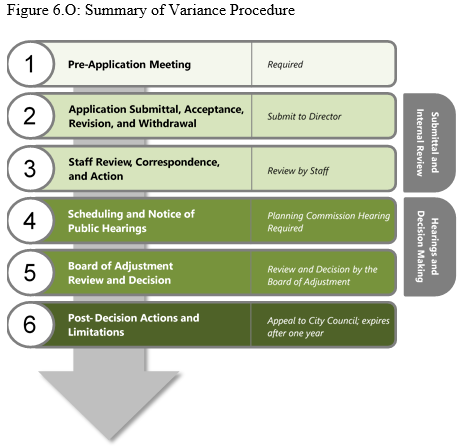
(A)
Pre-Application Meeting. A pre-application meeting shall be held in accordance with Subsection 11-6-3(b).
(B)
Application Submittal, Acceptance, Revisions, and Withdrawal. The variance application shall be submitted, accepted, and revised, and may be withdrawn, in accordance with Subsection 11-6-3(c). The application shall include all required information as indicated in the Administrative Manual and any additional information requested during the pre-application meeting.
(C)
Staff Review, Correspondence, and Action. The Director shall review the variance application and prepare a staff report and recommendation in accordance with Subsection 11-6-3(d).
(D)
Scheduling and Notice of Public Hearings. The variance application shall be scheduled for a public hearing before the Board of Adjustment, and noticed in accordance with Subsection 11-6-3(e).
(E)
Board of Adjustment Review and Action.
(i)
Hearing, Review, and Decision.
(a)
The Board of Adjustment shall hold a public hearing on the application in accordance with Subsection 11-6-3(g), Public Hearing Procedures.
(b)
The Board of Adjustment shall consider the application, relevant support materials, staff report, and any public comments made at the public hearing (if required), and shall approve, approve with conditions, or deny the variance based on the criteria below. The Board may also remand the application back to the Director for further consideration.
(c)
The Board of Adjustment's decision shall be based only on the record of the public hearing and shall be reduced to writing, include findings of fact based on competent, material, and substantial evidence presented at the hearing, reflect the determination of contested facts, and state how the findings support compliance with applicable review standards.
(d)
The Board of Adjustment shall clearly state the factors considered in making its decision, as well as the basis or rationale for the decision.
(ii)
Variance Approval Criteria.
(a)
In reviewing a variance application, the Board of Adjustment shall find that all of the following exist:
(1)
The variance is necessary due to unique physical conditions such as size, irregularity, narrowness or shallowness of a lot, location, surroundings, topography, or other peculiar conditions on the subject property;
(2)
The strict application of the UDO standards for which a variance is sought would produce undue hardship;
(3)
Such hardship is not shared generally by other properties in the same zoning district and the same vicinity;
(4)
Such hardship was not created by the applicant or any previous owner of the property;
(5)
The variance is the minimum variance that will afford relief of the subject standards of the UDO;
(6)
The variance will not be of substantial detriment to adjacent property or the character of the district; and
(7)
The variance is based on demonstrated exceptional hardship not related to purposes of convenience or financial burden.
(b)
A variance may also be granted by the Board of Adjustment where strict application of the UDO would prevent achieving a public purpose. A public purpose may include protection of public safety; provision of public facilities including roadways, walkways, trails, water and sewer utilities, and storm drainage facilities; provision of public or private landscaping and open space; and accommodation of beneficial economic development projects. No such variance shall be authorized by the Board of Adjustment unless it finds that:
(1)
The strict application of the UDO would prevent achieving a clearly defined public purpose;
(2)
The authorization of such variance will not be of substantial detriment to adjacent property; and
(3)
The character of the zoning district will not be changed by the granting of the variance.
(iii)
Post-Decision Actions and Limitations. Post-decision actions and limitations in Subsection 11-6-3(h) shall apply, with the following modifications:
(iv)
Notice of Decision. Within three business days following any decision by the Board of Adjustment, the Director shall provide written notification of such decision to the applicant.
(v)
Expiration of Variance. If the property owner has not commenced development or obtained the required permits to carry out the approved variance within one year of the variance approval, the variance shall automatically expire.
(vi)
Non-Transferable. An approved variance shall apply only to the property or structure described in the approval and shall not be transferable to any other property or structure.
(vii)
Appeal to District Court. The decision on a variance may be appealed to the District Court in accordance with Colorado law.
(b)
Administrative Adjustment.
(1)
Purpose. This section describes the review and approval procedures for administrative adjustments, which are minor modifications or deviations from the dimensional or numeric standards of this UDO that may be permitted by the Director. Administrative adjustments are intended to allow for greater flexibility to make slight adjustments without requiring a formal zoning amendment or variance. The administrative adjustment procedure is not intended to serve as a waiver of current standards of the UDO or to circumvent the variance procedure.
(2)
Applicability.
(A)
The administrative adjustment procedure shall apply to the standards and limitations established in Table 6.C, Allowable Administrative Adjustments.
(B)
The administrative adjustment procedure shall not apply to any proposed modification that results in:
(i)
An increase in the overall project density;
(ii)
A change in permitted uses or mix of uses;
(iii)
A deviation from the use-specific standards in Section 11-3-3, Use-Specific Standards;
(iv)
A deviation from sensitive area protection standards in Section 11-4-2, Sensitive Area Protection;
(v)
A deviation from floodplain regulations in Section 11-4-3, Regulations to Minimize Flood Losses;
(vi)
A change to a development standard already modified through a separate administrative adjustment or variance; or
(vii)
Requirements for public roadways, utilities, or other public infrastructure or facilities.
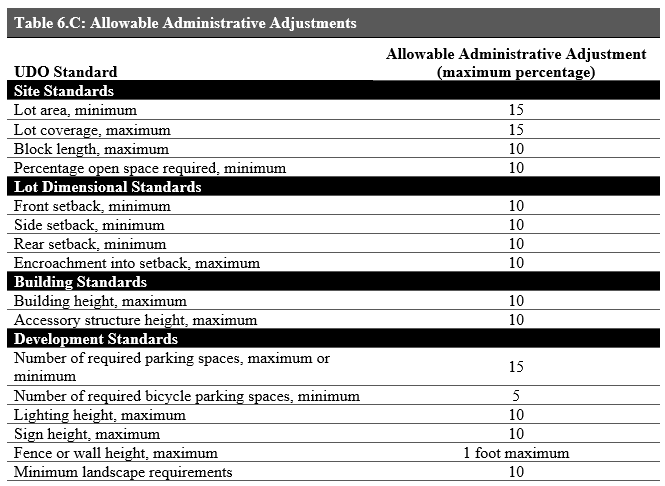
(3)
Administrative Adjustment Procedure. This subsection identifies the applicable steps from the common review procedures in Section 11-6-3 that apply to the review of administrative adjustments. Additions or modifications to the common review procedures are noted below.
(A)
Pre-Application Meeting. An optional pre-application meeting may be held in accordance with Subsection 11-6-3(b) at the applicant's discretion.
(B)
Application Submittal, Acceptance, Revision, and Withdrawal.
(i)
The administrative adjustment application shall be submitted, accepted, and revised, and may be withdrawn, in accordance with Subsection 11-6-3(c). The application shall include all required information as indicated in the Administrative Manual, and any additional information requested by the Director.
(ii)
An application for an administrative adjustment shall only be submitted and reviewed concurrently with an application for a special use permit, temporary use permit, change of use permit, site plan approval (minor or major), or plat approval (preliminary or final).
(C)
Staff Review, Correspondence, and Action.
(i)
Review and Decision.
(a)
Where the concurrently reviewed application is subject to review and approval by the Planning Commission and/or City Council, the Planning Commission and/or City Council shall review and decide the administrative adjustment application based on the criteria below.
(b)
The Director shall review all other administrative adjustment applications and shall approve, approve with conditions, or deny the adjustment request based on the criteria below.
(ii)
Administrative Adjustment Approval Criteria. In reviewing a proposed administrative adjustment, the Director, Planning Commission, and/or City Council shall consider whether and to what extent the adjustment:
(a)
Is consistent with the Comprehensive Plan;
(b)
Is consistent with the purpose of the applicable zoning district;
(c)
Will not result in incompatible development; and
(d)
Will not result in adverse impacts unless adequately mitigated; and/or
(e)
Is of a technical nature and is required to:
(1)
Compensate for an unusual site condition;
(2)
Eliminate a minor inadvertent failure to comply with a UDO standard; or
(3)
To protect a sensitive resource or natural feature.
(D)
Post-Decision Actions and Limitations. Post-decision actions and limitations in Subsection 11-6-3(h) shall apply, with the following modifications:
(i)
Effect of Approval. Approval of an administrative adjustment authorizes only the particular adjustment of standards approved, and only to the subject property of the application.
(ii)
Expiration of Approval. Approval of an administrative adjustment shall automatically expire if the associated development application is denied or if approval of the concurrently reviewed application expires, is revoked, or otherwise becomes invalid.
(c)
Vested Rights.
(1)
Purpose. This section describes the procedure for approval of vested real property rights pursuant to state statutes C.R.S. Article 68 of Title 24, as amended. Nothing in this section is intended to create a vested property right, but only to implement the provisions of state law.
(2)
Applicability.
(A)
Vested property rights shall be obtained through approval of the following site-specific development plans:
(i)
Final plat;
(ii)
Minor site plan;
(iii)
Major site plan; or
(iv)
Planned Development.
(B)
No other plan, plat, or similar document shall be considered a site-specific development plan.
(3)
Vested Rights Procedure. Figure 6.P identifies the applicable steps from the common review procedures in Section 11-6-3 that apply to the review of vested rights. Additions or modifications to the common review procedures are noted below.
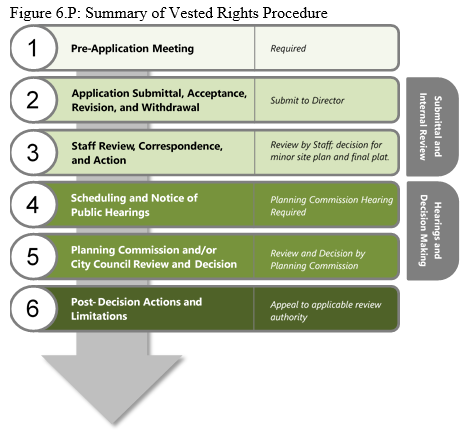
(A)
Pre-Application Meeting. A pre-application meeting shall be held in accordance with Subsection 11-6-3(b). The vested rights shall be discussed as part of the pre-application meeting for the applicable site-specific development plan.
(B)
Application Submittal, Acceptance, Revisions, and Withdrawal.
(i)
The vested rights request shall be included with an application for the site-specific development plan, which application shall be submitted, accepted, and revised, and may be withdrawn, in accordance with Subsection 11-6-3(c).
(ii)
The application shall include all required information as indicated in the Administrative Manual and any additional information requested during the pre-application meeting.
(iii)
If the applicant seeks approval of a site-specific development plan to create vested property rights, the plan shall include a statement that is being submitted for designation as a site-specific development plan. Failure to include such statement shall result in no vested property rights being created by the approval of the site-specific development plan.
(C)
Staff Review, Correspondence, and Action.
(i)
The Director shall review the vested rights application and prepare a staff report and recommendation in accordance with Subsection 11-6-3(d). The recommendation for vested rights may be incorporated directly into the staff report for the applicable site-specific development plan.
(ii)
For applications decided by the Director, vested rights shall be included with the official decision per the applicable site-specific development plan procedure.
(D)
Scheduling and Notice of Public Hearings. If required, the applicable site-specific development plan application shall be scheduled for public hearings before the Planning Commission and City Council, and noticed in accordance with Subsection 11-6-3(e). Hearings on vested rights may occur concurrently with the applicable site-specific development plan.
(E)
Planning Commission and/or City Council Review and Decision.
(i)
Planning Commission Review, Recommendation, and/or Decision. If required for a site-specific development plan pursuant to the specific application type, the Planning Commission shall review the site-specific development plan application and make a recommendation and or decision in accordance with Subsection 11-6-3(f). If the Planning Commission is the deciding authority, the Planning Commission shall make one of the decisions according to the procedures for that site-specific development plan. The vested rights approved with any site-specific development plan shall be three years unless an extended duration is approved pursuant to state law.
(ii)
City Council Review and Decision. If required for a site-specific development plan pursuant to the specific application type, the City Council shall review the site-specific development application and make a decision in accordance with Subsection 11-6-3(f). The City Council shall make one of the decisions according to the procedures for that site-specific development plan. The vested rights approved with any site-specific development plan shall be three years unless an extended duration is approved pursuant to state law.
(F)
Post-Decision Actions and Limitations. Post-decision actions and limitations in Subsection 11-6-3(h) shall apply, with the following modifications:
(i)
Approval of a site-specific development plan shall not constitute an exemption from or waiver of any other provisions or requirements of the City pertaining to the development and use of the property adopted prior to the approval of a site-specific development plan.
(ii)
Prior to approval of a site-specific development plan, the City may impose conditions on such approval. Failure to abide by any terms or conditions imposed by the City on the approval of any site-specific development plan shall constitute a forfeiture of any vested right created by the plan, unless otherwise expressly agreed to by the City in writing.
(iii)
A site-specific development plan submitted by a landowner and approved by the City as provided in this section shall supersede any prior vested property rights for that property, and the landowner waives any right to claim a vested property right by a site-specific development plan previously approved by the City or any other local government for the property.
(iv)
It shall be the applicant's responsibility to comply with the publication requirements of C.R.S. § 24-68-103(1)(c) following approval of a site-specific development plan by the City. The applicant shall provide a copy of said notice to the City within 10 days of publication.
(d)
Appeal.
(1)
Purpose. The purpose of this section is to establish remedies whereby persons claiming to having been aggrieved by a decision of the Director, administrative official, Board, Commission, or Council, in administering this UDO may appeal that decision.
(2)
Applicability. Any person may appeal any decision of any administrative officer or agency made in the administration or enforcement of this UDO. Appeals shall be made to the appropriate body as indicated in Table 6.A, Summary Table of Development Review Procedures, with the following additions and/or exceptions:
(A)
Appeals of Decisions made by Boards/Commissions other than Planning Commission. Appeals of decisions by boards and commissions except for the Planning Commission shall be made to the Board of Adjustment, except that appeals of comprehensive plan amendments shall be made to the City Council.
(B)
Appeals of Director Decisions. Appeals of administrative decisions made by the Director shall be appealed to the Planning Commission, except that appeals of UDO interpretations shall be appealed to the Board of Adjustment.
(C)
Appeals of City Council and Board of Adjustment Decisions. Appeals of decisions by the City Council and Board of Adjustment shall be made to the District Court in accordance with Colorado law.
(3)
Procedure. Figure 6.Q identifies the applicable steps from the common review procedures in Section 11-6-3 that apply to the review of appeals. Additions or modifications to the common review procedures are noted below.
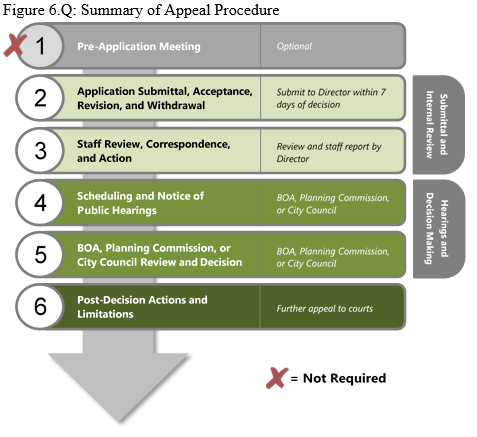
(A)
Pre-Application Meeting. An optional pre-application meeting may be held in accordance with Subsection 11-6-3(b) at the applicant's discretion.
(B)
Application Submittal, Acceptance, Revisions, and Withdrawal. An appeal application shall be submitted, accepted, and revised, and may be withdrawn, in accordance with Subsection 11-6-3(c), with the following modifications:
(i)
Burden of Proof on Appellant. The appellant has the burden of proving the necessary facts to warrant approval of an appeal by the appropriate decision-making body. Such proof shall be provided at time of application.
(ii)
Time limit. Appeals shall be made in writing and filed with the Director within seven days of the action or decision being appealed.
(iii)
Stay of Proceedings. An appeal stays all proceedings from further action unless the Director determines that a stay would create adverse impacts to the health, safety, or welfare of the City or neighborhood.
(C)
Staff Review, Correspondence, and Action. The Director shall review the application and prepare a staff report in accordance with Section 11-6-3(d), with the following modifications:
(i)
Staff review shall only confirm that the application is complete and that the appeal is heard by the appropriate authority.
(ii)
The staff report shall not make a formal recommendation. The report shall include necessary facts to warrant an appeal, which shall be provided by the appellant/applicant.
(D)
Scheduling and Notice of Public Hearings. An appeal shall be scheduled for public hearings before the Board of Adjustment, Planning Commission, or City Council, and noticed in accordance with Subsection 11-6-3(e).
(E)
Board of Adjustment, Planning Commission, or City Council Review and Decision
(i)
The appropriate decision-making body shall consider the following in determining whether to affirm, reverse, or amend a decision or interpretation made by another decision-making body:
(a)
The facts stated in the application, as presented by the appellant and/or the Director;
(b)
The requirements and intent of the applicable standards from this UDO compared to the written decision that is being appealed;
(c)
Evidence related to how the applicable standards from this UDO have been administered or interpreted in the past; and
(d)
Consistency with the Comprehensive Plan.
(ii)
The appeal decision-making authority may reverse a previous decision in whole or in part, or may modify the order, requirement, decision, or determination appealed from.
(iii)
The appeal decision-making authority may attach conditions of approval on any appeal to ensure the health, safety, and welfare of the City.
(F)
Post-Decision Actions and Limitations. Post-decision actions and limitations in Subsection 11-6-3(h) shall apply. Any further appeals from the appropriate appeal decision-making authority shall be made to the courts, as provided by law; provided that such appeal is made within 60 days of that decision-making authority's decision.
(e)
UDO Interpretation.
(1)
Purpose. The purpose of this section is to establish an administrative procedure for making determinations and interpretations of the intent, meaning, or application of the stated provisions of this UDO.
(2)
Applicability. The UDO interpretation procedure applies to both applications submitted to the Director for written interpretations and internal staff requests for written interpretations of provisions of this UDO.
(3)
Procedure. Figure 6.R identifies the applicable steps required for written interpretations of the UDO. Additional details are provided below.
(A)
Application Filing. An application shall be submitted on a form established by the Director.
(B)
Director Review and Decision. Within 30 days of receipt of a complete application for a written interpretation, the Director shall:
(i)
Review and evaluate the application with regard to the UDO and any other relevant regulations or documents;
(ii)
Consult with the City Attorney and/or other staff departments as necessary;
(iii)
Issue a written interpretation.
(C)
Documentation of the Interpretation.
(i)
Official record of written interpretations shall be kept on file in the office of the Director. The record of interpretations shall be available for public inspection during normal business hours of the Planning and Development Department.
(ii)
The written interpretation shall be distributed to the applicant and any relevant staff departments as necessary.
(D)
Post-Decision Actions.
(i)
UDO Text Amendments. Following issuance of a written interpretation, the Director shall determine whether or not such interpretation warrants an amendment to the UDO. To make such determination, the Director shall evaluate whether or not clearer language, additional graphics, or removal of inconsistent language would facilitate administration of the provision that was subject to the interpretation. Should the Director determine that an amendment to the UDO is warranted; such amendment shall follow the procedures in Section 11-6-4(c), Unified Development Ordinance Amendment.
(ii)
Appeals. A written interpretation may be appealed to the Board of Adjustment pursuant to Subsection 11-6-7(d), Appeal.
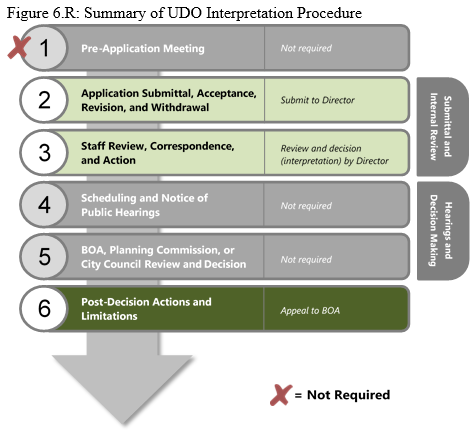
[Source: Ord. 1766, 2019; 1782, 2019]
Section 11-6-8. Review and Decision-Making Bodies.
(a)
Purpose. This section establishes and describes the authority, basic duties, and operating procedures for decision-making bodies in the City of Northglenn responsible for administering and enforcing this UDO.
(b)
City Council.
(1)
Legislative Body. The City Council is the governing body of the City and has sole authority to adopt or amend provisions in this UDO and the Zoning Map.
(2)
Powers and Duties under this UDO. To exercise the authority granted it by State law and the City Charter, the City Council shall have the following powers and duties under this UDO.
(A)
Review of Development Applications. The City Council shall have the review and decision-making authority and responsibilities shown in Table 6.A, pursuant to the application-specific procedures outlined in this article.
(B)
Adopt Schedule of Development-Related Fees. The City Council is authorized to adopt, by resolution, a schedule of fees governing the review of development applications and plans, inspections, and other matters involving the administration and enforcement of this UDO.
(C)
Adopt Schedule of Civil Penalties. The City Council is authorized to adopt, by ordinance, a schedule of civil penalties for violations of this UDO.
(D)
Other Actions. The City Council is authorized to take any other action not assigned or delegated to the Director, Planning Commission, or other advisory or design-making authority as the City Council deems desirable and necessary to implement provisions of this UDO, and as authorized by State law and the City Charter.
(3)
Other Powers and Duties. Other powers and duties of the City Council are set forth in Chapter 2, Article 2-2 and Chapter 3, Article 3-3 of the City of Northglenn Municipal Code, and in the City Charter.
(c)
Planning Commission.
(1)
Powers and Duties. The Planning Commission shall have the review and decision authority as shown in Table 6.A, Summary of Development Review Procedures, pursuant to the application-specific procedures outlined in this article and according to the Rules of Order and Procedure of the Northglenn Planning Commission, as amended. The Planning Commission also has the powers and duties permitted under Colorado law, C.R.S. §31-23-201 et seq.
(2)
Membership.
(A)
Generally.
(i)
The Planning Commission shall consist of eight members, seven of whom shall be voting members, one of whom shall be an alternate member that will fill-in for an absent member, and one of whom shall be a non-voting ex-officio member. Each member shall be a resident of the City of Northglenn.
(ii)
Citizen members of the Planning Commission shall be appointed by resolution of the City Council. The term of each citizen member shall be three years or until his or her successor takes office.
(iii)
The ex-officio member of the Planning Commission shall be appointed by the City Council, by resolution, from among the membership of the Council, including the Mayor. The term of the ex-officio member shall be provided in the appointing resolution and shall continue for such period and until the ex-officio member's successor takes office, or until the termination of the ex-officio member's official tenure as such Councilmember or Mayor. The ex-officio member will have no vote on matters before the Planning Commission.
(iv)
The Commission shall elect a Chair from among its voting members, for a term of one year, with eligibility for re-election.
(v)
The Commission shall choose one of its voting members as a Vice-Chair to perform the same functions as the Chair during the disqualification, absence, or disability of the Chair.
(vi)
No elected officer of the City or member of the Northglenn Urban Renewal Authority shall be a member of the Planning Commission during his or her term of elected office.
(vii)
No employee of the City shall be a member of the Planning Commission during the term of employment.
(viii)
Any member of the Planning Commission shall be eligible for reappointment or for appointment to a different term.
(ix)
The Planning Commission shall be a continuing body. Planning Commission proceedings shall be unaffected by the expiration of the term of any one or more of the members.
(x)
The Planning Commission shall be a continuing body. Planning Commission proceedings shall be unaffected by the expiration of the term of any one or more of the members.
(B)
Investigation and Recommendation. The Planning Commission may interview and investigate the qualifications of applicants for appointment as members of the Planning Commission and make reports and recommendations to the Council.
(C)
Termination.
(i)
Members of the Planning Commission may be removed by the City Council, after public hearing, for neglect of duty or misconduct in office. Such public hearing shall be held only after the filing by the Mayor or any Council Member of written charges and upon proper notice.
(ii)
The election of any member of the Planning Commission to municipal office of the City shall terminate the term of such member as of the date of commencement of the term of elected office.
(iii)
The term of any member of the Planning Commission shall terminate in the event such member shall cease to be a bona fide resident of the City.
(D)
Vacancies.
(i)
A vacancy on the Planning Commission shall exist upon the resignation, death, or removal of any member, or upon the termination of the term of any member otherwise than by expiration of the member's term.
(ii)
Any vacancy on the Planning Commission shall be filled, for the balance of the unexpired term, in the manner provided by this section.
(3)
Comprehensive Plan. In accordance with provisions contained in Colorado Revised Statutes § 31-23-206 et seq., the Planning Commission is directed to make and adopt a Comprehensive Plan for the physical development of the City of Northglenn. The Planning Commission may adopt the Plan as a whole by a single resolution or by successive resolutions, adopt successive parts of the Plan, said parts corresponding with major geographical sections or division of the subject matter of the Plan, and may adopt any amendments or extensions thereof or addition thereto. All proposed Comprehensive Plans shall be referred to the Planning Commission for study, consideration, and adoption. The Planning Commission's Adoption of the Plan, in whole or part, shall then be ratified by the Northglenn City Council.
(4)
Meeting Procedures.
(A)
The Planning Commission shall hold at least one regular meeting in each month on a day and time set by the Planning Commission, which shall not be changed more than once in any year.
(B)
The Planning Commission may cancel its regular meeting upon notification that there are no matters scheduled to be considered by the Planning Commission.
(C)
All meetings of the Planning Commission shall be open to the public.
(D)
The Planning Commission shall keep minutes of its proceedings, showing the vote of each member on each question, or if absent and failing to vote, indicating such fact, and shall keep records of its examinations and other official actions, all of which shall be immediately filed in the office of the City of Northglenn and shall be public records.
(E)
The Planning Commission shall propose rules for the transaction of business for review and adoption by the City Council. Except as provided by ordinance, the proceedings and meetings of the Planning Commission shall be governed by such rules.
(F)
The Planning Commission may by resolution appoint any one or more of its members as a referee or board of referees for the purpose of receiving evidence, conducting an investigation, compilation of data, and/or for the preparation and presentation to the Planning Commission of proposed findings and conclusions concerning any matter before the Planning Commission under the provisions of this UDO. Any referee or referees so appointed shall have and exercise the powers of the Planning Commission in the performance of the duties and functions provided by the appointing resolution.
(d)
Board of Adjustment.
(1)
Powers and Duties. The Board of Adjustment shall have the review and decision authority as shown in Table 6.A, pursuant to the application-specific procedures outlined in this article.
(2)
Membership.
(A)
Generally. The membership of the Board of Adjustment shall be the same as the Planning Commission, pursuant to Subsection 11-6-8(c)(2).
(B)
Regular Members and Officers. The Board of Adjustment shall elect a Chairman and Vice-Chairman, and appoint a secretary among its members. Each term shall be for one year.
(3)
Voting.
(A)
A concurring vote of four members of the Board of Adjustment shall be necessary to:
(i)
Reverse any order, requirement, decision, or determination of an administrative official;
(ii)
Decide in favor of the applicant required for approval under the provisions of this UDO; or
(iii)
Grant a variance from this UDO.
(B)
Except as provided in paragraph (A), the business of the Board of Adjustment shall be transacted by such vote of the membership as the Board of Adjustment shall prescribe by the meeting procedures in Subsection (4) below.
(4)
Meeting Procedures.
(A)
Meetings of the Board of Adjustment shall be held at the call of the Chair and at such other times the Board in its Rules of Procedure shall specify.
(B)
The Chair, Vice-Chair in the absence of the Chair, or an acting Chair may administer oaths and require the attendance of witnesses by application to the District Court.
(C)
All meetings of the Board of Adjustment shall be open to the public.
(D)
The Board shall keep minutes of its proceedings, showing the vote of each member on each question, or if absent and failing to vote, indicating such fact, and shall keep records of its examinations and other official actions, all of which shall be immediately filed in the office of the City of Northglenn and shall be public records.
(E)
The Board of Adjustment may adopt rules and procedures consistent with this UDO.
(e)
Director of Planning and Development. The Director shall have the review and decision-making authority as shown in Table 6.A to be carried out in accordance to the provisions of this UDO.
(f)
Other City Administration.
(1)
City Manager. See Chapter 2, Article 2-3 of the City of Northglenn Municipal Code.
(2)
Building Official. The Director of Planning and Development shall be the building official, with authority pursuant to Chapter 10, Section 10-1-3 of the City of Northglenn Municipal Code
[Source: Ord. 1766, 2019; 1851, 2023]
